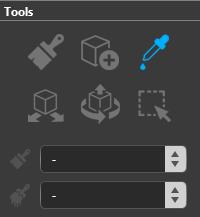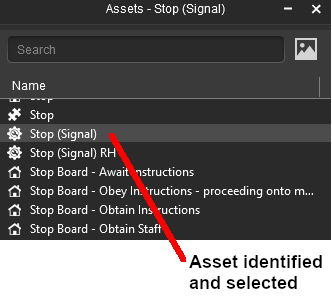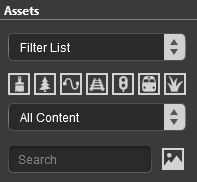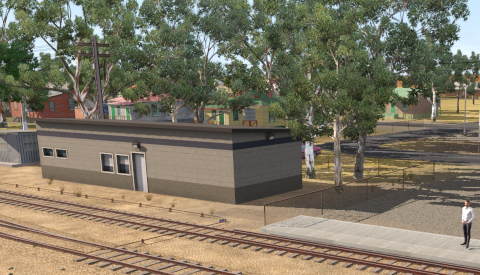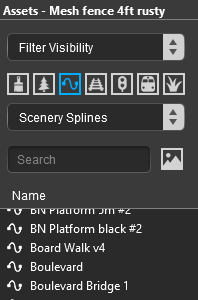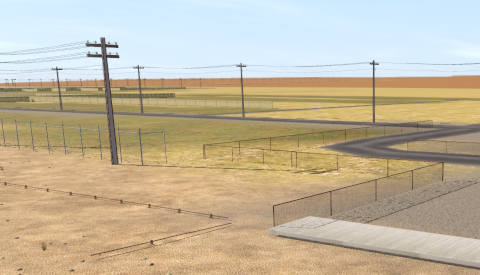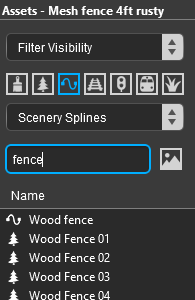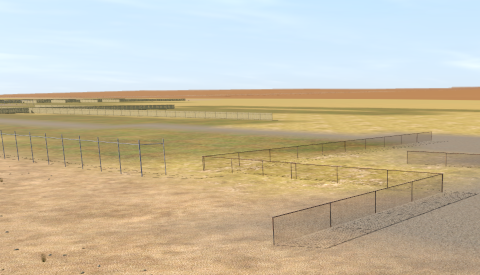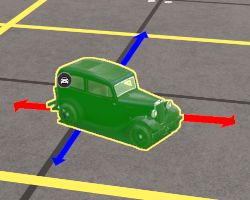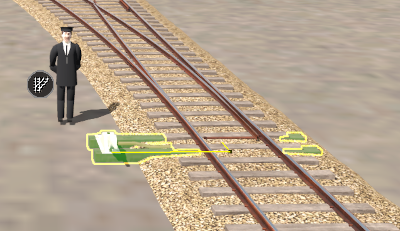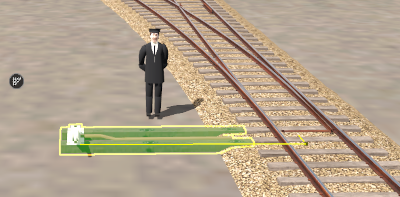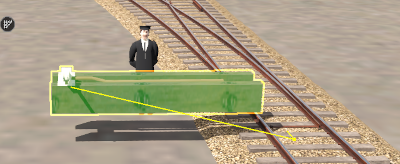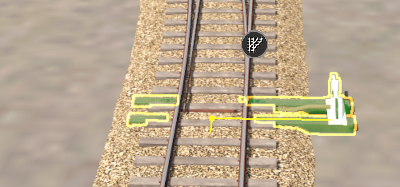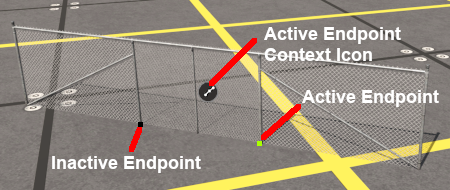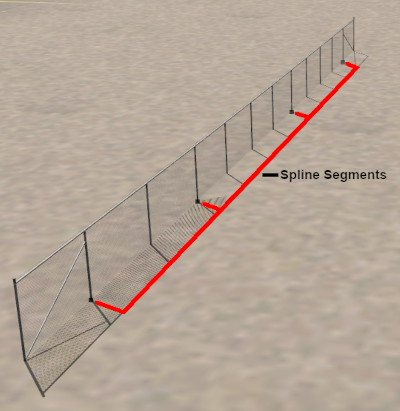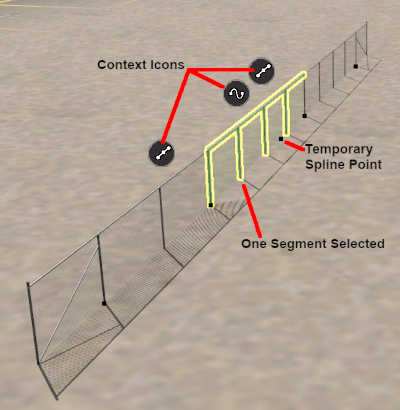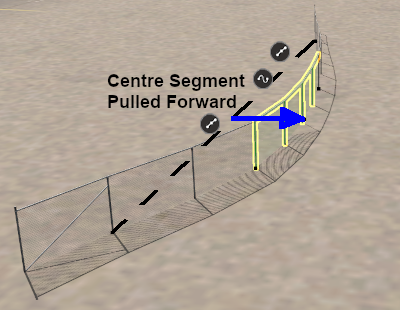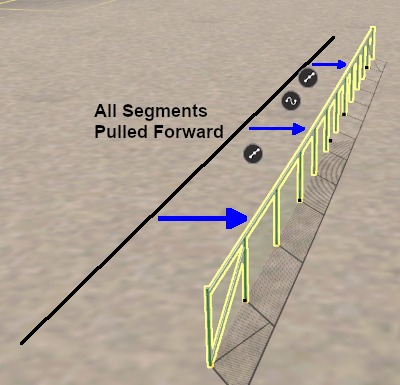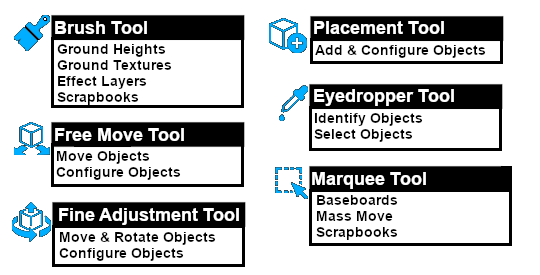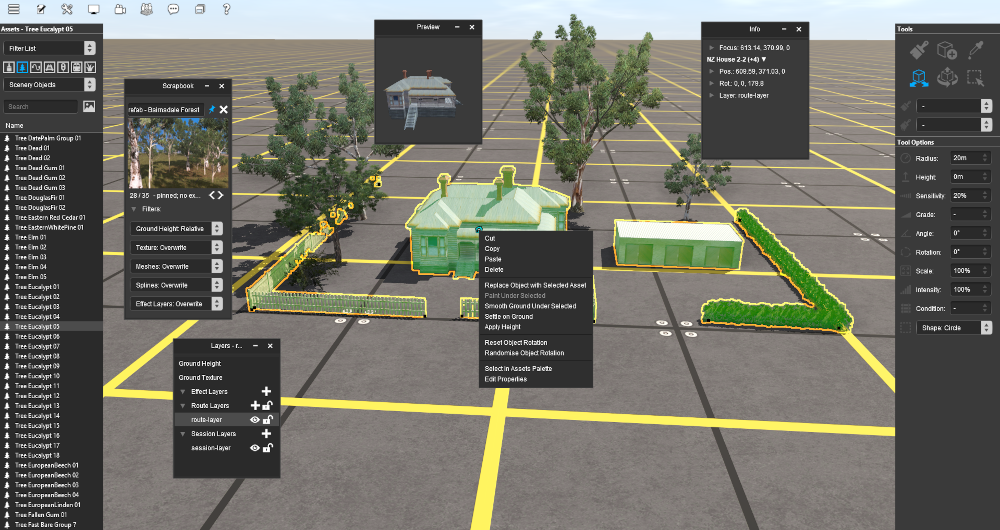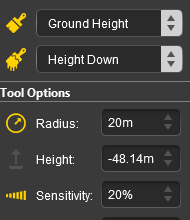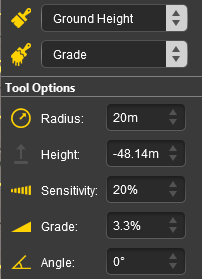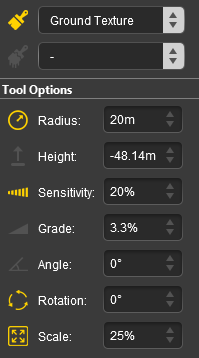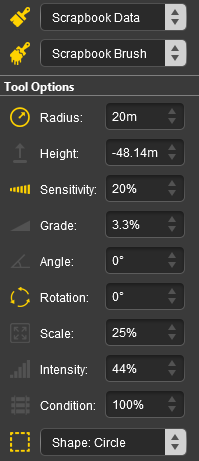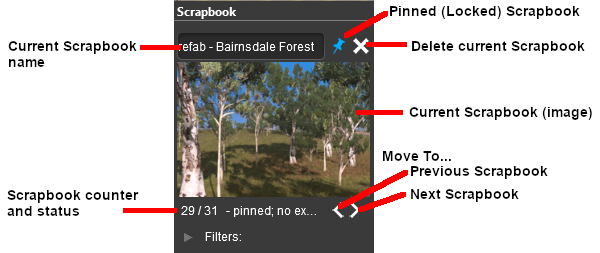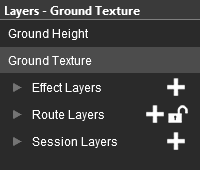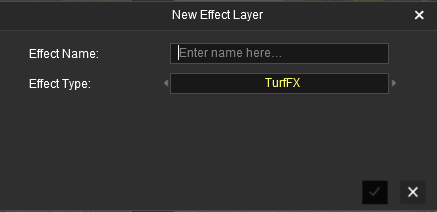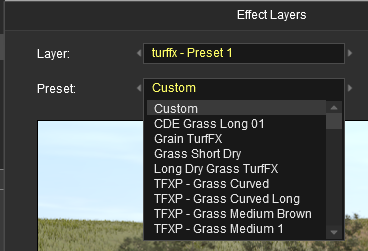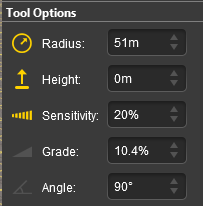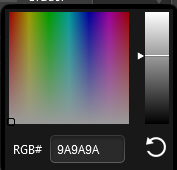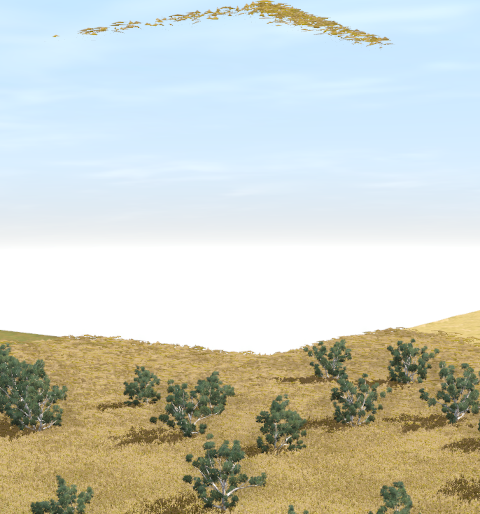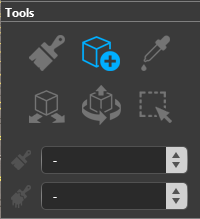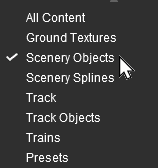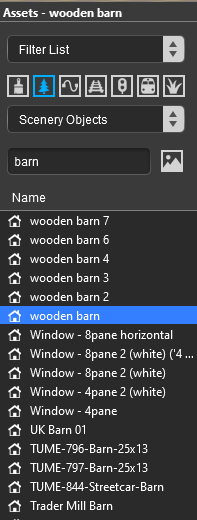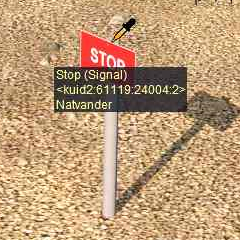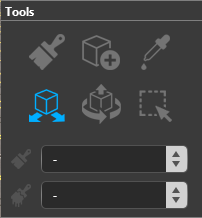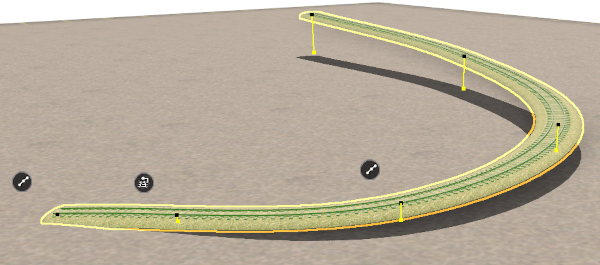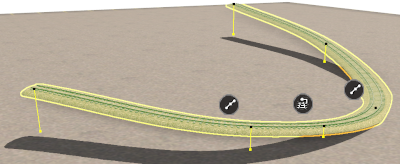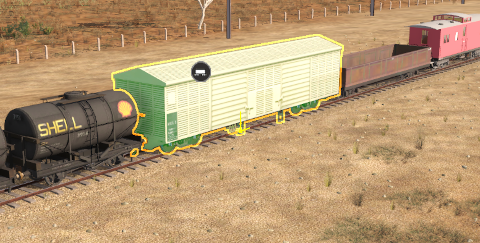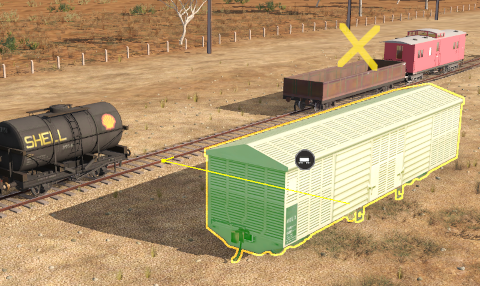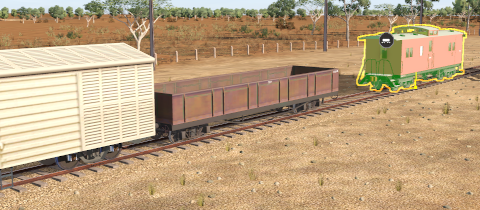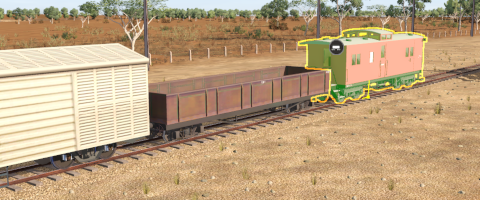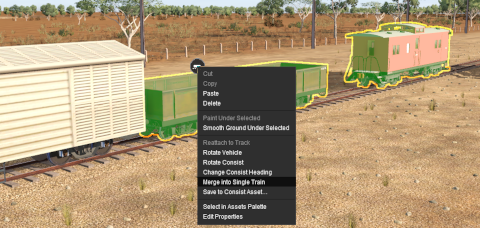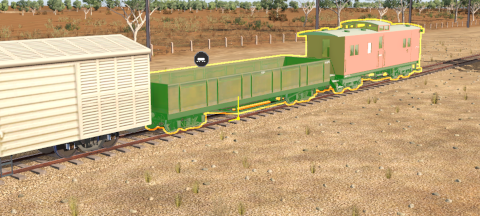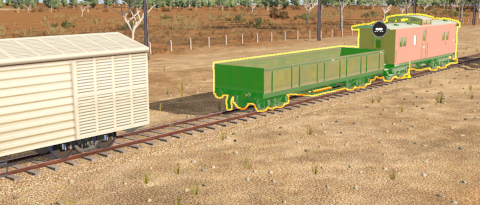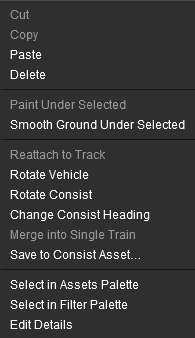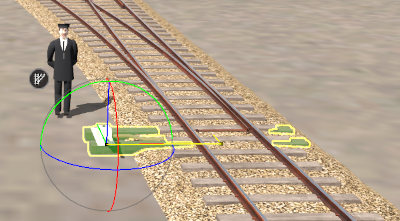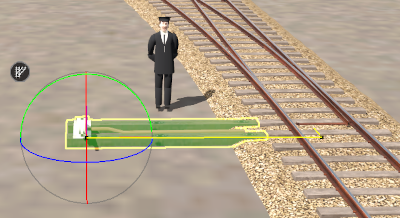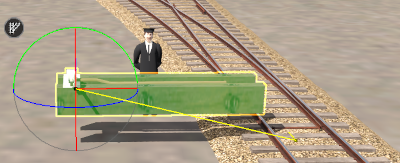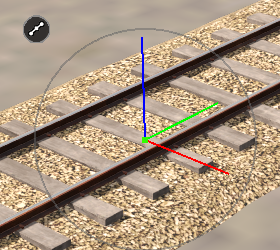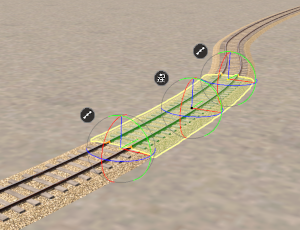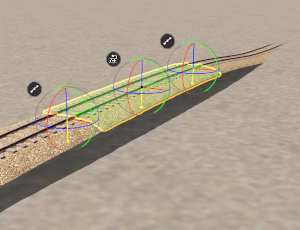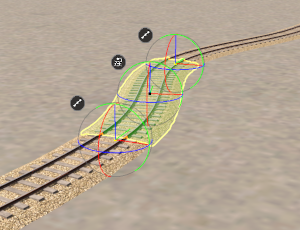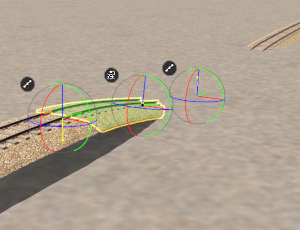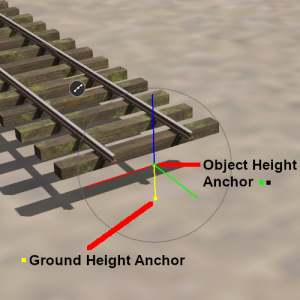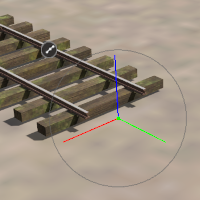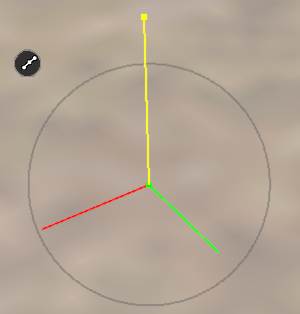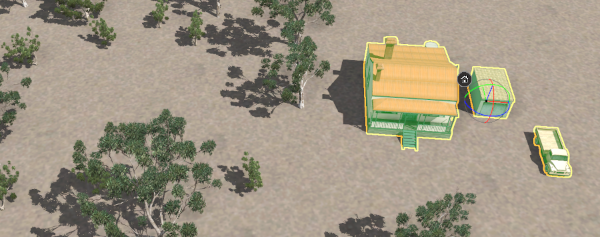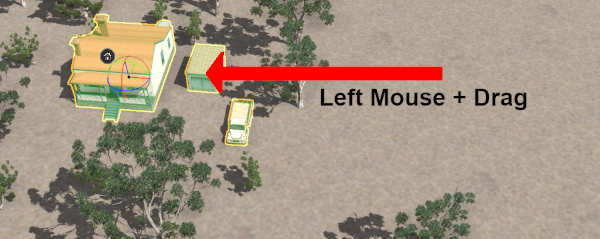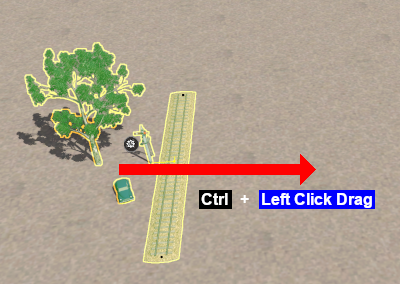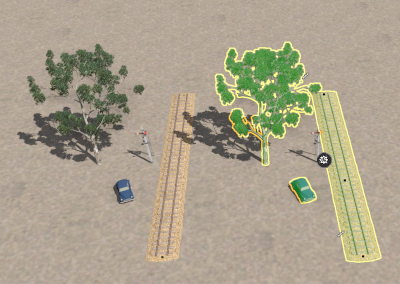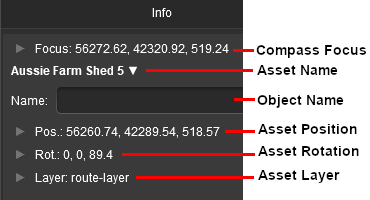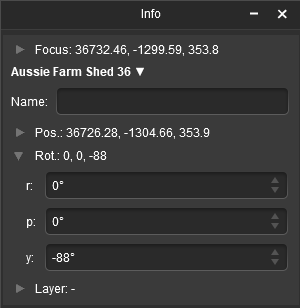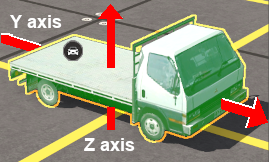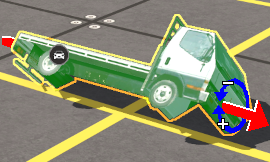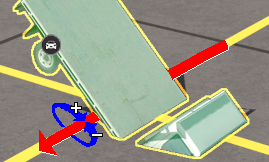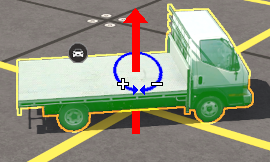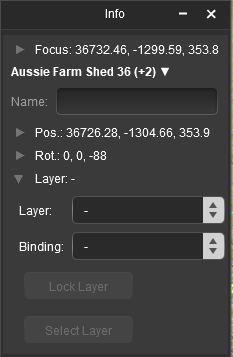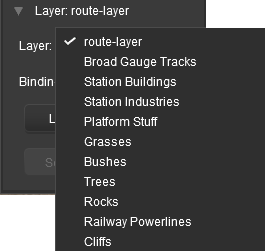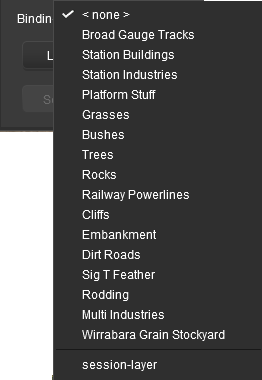|
Free Move: Move Rolling Stock Objects
|
|
|
  |
|
|
|
Use the Free Move tool to move a selected rolling stock object along the track.
 |
Rolling Stock Objects are always attached to a track segment. They can be moved along the track or to a different track but they cannot be moved to a position that is to the left, right, above or below the track |
|
 | To move an entire consist of rolling stock objects, Double Left Click on any one of the objects in the consist to select them all and then move them as one object |
|
Free Move: Decouple Rolling Stock Objects
|
|
|
  |
|
|
|
 |
All decoupling operations between Rolling Stock Objects are performed using just a Left Click and Drag. |
 | To decouple a rake of joined rolling stock objects from a consist (for example, the first or last 5 wagons), Shift + Left Click on each of the objects to be selected and then drag them away from the consist |
|
A rolling stock object or objects in the middle of a consist can also be decoupled. This will break the consist into 3 sections.
Free Move: Couple Rolling Stock Objects
|
|
|
  |
|
|
|
 |
All coupling operations between Rolling Stock Objects can be performed using just a Left Click and Drag or through the objects Context Menu. |
Options:
 Using "Click and Drag" Using "Click and Drag"
Consider the following simple situation:-
 Using the Context Menu Using the Context Menu
Using the same situation as above, the isolated guard van and the gondola wagon at the end of a consist are to be coupled together.
There are two possible outcomes depending on which object has the Context Icon
| Using a more complex example involving multiple objects from several different consists. The selected wagons shown below are to form a single consist based on the loco. |
 |
| The loco was the last object to be selected so it has the Context Icon. The Context Menu is opened and the option Merge into Single Train is selected with the result as shown below. |
 |
| The wagons and loco have been combined into a single consist but not necessarily in a useful order. Left Click and Drag the incorrectly placed vehicles to their correct positions. |
| A selected rolling stock object, or a group of selected rolling stock objects, will have a Context Icon that opens a Context Menu. The icon design will vary between object types. |
To open a selected rolling stock object's Context Menu choose one of the following:-
| Options: |
 |
Left Click its Context Icon  OR OR |
 |
Press the T key |
|
|
|
 |
You cannot add rolling stock assets to a Scrapbook but you can create and save Consist Assets that have multiple rolling stock objects
| Steps: To create a Consist Asset:- |
 |
select the consist - Double Left Click on the consist or Shift + Left Click on individual items |
 |
open the consist Context Menu - Left Click on its icon or press the T key |
 |
select the option Save to Consist Asset... |
 |
enter a name and an optional description for your new Consist Asset and click the  icon icon |
| The consist will appear as a Train Asset in the Assets Palette |
|
|
|
 |
Keyboard Shortcut: D |
|
|
The Fine Adjustment Tool makes 3D adjustments (XYZ position and rotations) to objects in a Trainz World |
This tool uses the Tool Options Palette. If this palette is not visible on the screen then refer to  Notes: Palettes at the top of this document. Notes: Palettes at the top of this document.
|
|
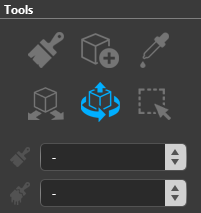 |
| Tool Targets The Fine Adjustment Tool has no Target options so it has no drop down menu list |
 |
This tool is ideal for making small adjustments to objects - horizontally, vertically and rotations in 3D space |
 |
Multiple objects (of different types) can be selected for mass adjustments and other operations |
|
| Tool Actions The Fine Adjustment Tool has no Action options so it has no drop down menu list |
|
|
 | Fine Adjustment Alternatives |
| In addition to the Fine Adjustment Tool the position, orientation and/or height of objects can be changed by choosing one of the following:- |
| Options: |
 |
using the  Free Move Tool OR Free Move Tool OR |
 |
editing its x y z position values and r p y rotation values in  The Info Palette OR The Info Palette OR |
 |
selecting the Apply Height option in its Context Menu |
|
 |
The most obvious feature of the Fine Adjustment Tool is the 3D Anchor Frame it adds to a selected object. The frame is made of 3 straight and 3 curved coloured lines, called Anchors |
 |
The Anchors in the Fine Adjustment Tool are used to move and rotate a selected object, or a group of selected objects, through 3D space. |
 |
The Anchor controls are:-
| The Horizontal and Vertical Anchors |
| Red Green Blue |
move the object (forward/back or up/down) in the direction of the Anchor line |
| The Rotational Anchors |
| Red Green Blue |
rotate the object (clockwise and anti-clockwise) along the Anchor Arc Line centred around the Anchor Straight Line of the same colour |
 |
Not all objects will have Red and/or Green rotational Anchors. |
|
|
| The Object Anchor |
| (black central dot) moves the object in any horizontal direction |
|
 |
The orientation of the Red and Green horizontal anchor lines is based on the orientation of the object when it is placed in the scene, not on the compass directions |
|
|
| Steps: To use the Fine Adjustment Tool controls:- |
 |
move the tool pointer onto an Anchor - its colour will change to yellow for Anchor lines or green for the Object Anchor |
 |
Left Click and Drag the Object Anchor in any direction or move the pointer along the chosen Anchor Line in the required direction (e.g. up on the blue vertical Anchor or clockwise around the arc of the red rotational Anchor) |
|
|
 | To achieve finer and more accurate control when moving anchors, choose one of the following:- |
| Options: |
 |
zoom in closer to the anchor point, OR |
 |
use the x y z fine adjustment arrows in the Info Palette object Pos: controls. These arrows can be used to set the height and position to cm accuracy (see  The Info Palette below), OR The Info Palette below), OR |
 |
use the r p y fine adjustment arrows in the Info Palette object Rot: controls. These arrows can be used to set the rotation to 1° accuracy (see  The Info Palette below). The Info Palette below). |
|
Fine Adjustment: Selecting an Object
|
 |
 |
|
 |
|
|
 |
The Fine Adjustment Tool can be used to select individual objects and multiple objects. The multiple objects can be of different types (e.g. spline objects and scenery objects) |
 |
Selecting Objects From a Crowded Scene
Sometimes the object you want to select is part of a crowded scene or is overlapped by other objects, such as splines, and this can make it difficult to select. In these situations the best solution is to create an Object Filter using the Assets Palette to narrow the selection to a single object or to a set of objects.
See  Narrowing the Search for more details Narrowing the Search for more details |
|
Fine Adjustment: Naming an Object
|
 |
 |
|
 |
|
|
If the Info Palette is not visible on the screen then refer to  Notes: Palettes at the top of this document. Notes: Palettes at the top of this document. |
|
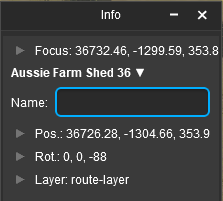 |
| Steps: To name (or rename) an object using the Fine Adjustment Tool:- |
 |
With the Fine Adjustment Tool Left Click inside the Name text entry box in the Info Palette |
 |
Enter a name |
 |
Press the Enter key |
|
|
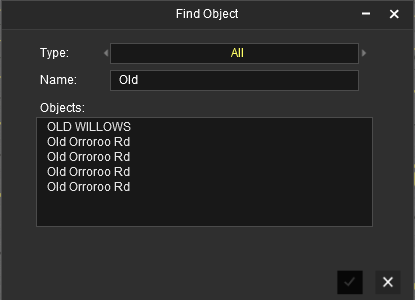 |
| There is no ban on two or more objects using the same name |
|
In the image shown on the left there are 4 objects all named Old Orroroo Rd.
This will not cause any problems for scenery objects apart from finding the exact one you want with the Finder Tool ( Ctrl + F keys).
 |
Notes:
However, duplicated names will cause problems for Industries (including passenger enabled stations), Locomotives, Track Marks, Triggers, Switches, Signals, etc that have to be identified to control the operation of a session. |
| These objects must have unique names |
|
|
Fine Adjustment: Changing an Objects Layer
|
 |
 |
|
 |
|
|
 |
All objects in the Trainz World are in layers. You can set and change the layers where the objects are placed |
If the Info Palette is not visible on the screen then refer to  Notes: Palettes at the top of this document Notes: Palettes at the top of this document |
|
| An object will be added to a layer when it is placed into the Trainz World by the Placement Tool and the Scrapbook. Once it has been placed it can be moved to a different layer. |
 |
| Steps: To move a placed object to another layer:- |
 |
select the object ( Left Click on the object) or several objects ( Shift + Left Click on each object) to be moved to another layer. If multiple objects are selected then they do not have to be of the same type or in the same starting layer. Note: The layer(s) containing the object(s) must NOT be locked |
 |
Left Click on the Layer arrowhead icon (circled in red in the image left) in the Info Palette. This will open up the layer controls for the last selected object |
 |
the drop down menu box labelled Layer shows the currently assigned layer for that object. If multiple objects from different layers have been selected then no layer name will be shown. Left Click on the Up/Down arrows to open the list of all available layers. |
 |
select the destination layer from the list. The object(s) will then be moved to the selected layer - you will be given a warning if the move has failed (usually because an objects layer is locked) |
 |
Also see:-
|
|
|
|
Fine Adjustment: Scenery Mesh Objects
|
 |
 |
  |
 |
|
|
 |
Individual "non-spline" scenery objects that are not attached to track are often referred to in Trainz terminology as Scenery Mesh Objects. |
Fine Adjustment: Move a Scenery Mesh Object
|
|
|
  |
|
|
|
| To move an object with the Fine Adjustment Tool choose one of the following:- |
| Options: |
 |
Left Click and Drag anywhere on the selected object (except on an Anchor line) to move it freely in any horizontal direction |
|
OR |
 |
Left Click and Drag on an Anchor line to move or rotate it in the direction of the line or arc |
| These operations can also be performed on a group of selected objects. The 3D Anchor Frame will be on the last object added to the group. |
|
Using the Anchors
Blue vertical Anchor movement
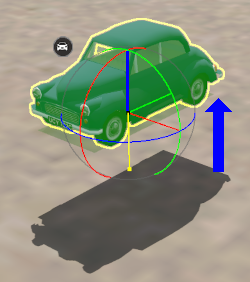 |
|
Green Anchor rotation
 |
|
Red Anchor rotation
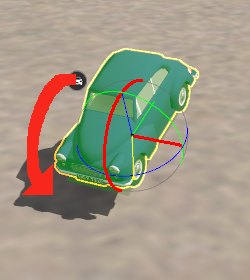 |
|
Blue Anchor rotation
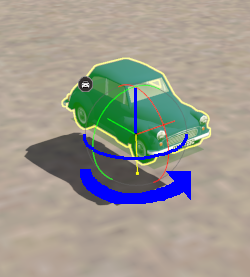 |
 |
Notes:
|
 |
Not all objects will have Red or Green Rotational Anchors |
 |
Objects can be restored to their original height and rotation settings by opening their Context Menu and choosing one of the following:-
| Options: |
 |
Reset Object Rotation to cancel the rotation changes, OR |
 |
Settle on Ground to cancel the height change |
|
 |
The Randomise Object Rotation option in the Context Menu only affects rotations around the vertical axis - the Blue Rotational Anchor.
|
|
Fine Adjustment: Set the Height of a Scenery Mesh Object
|
|
|
  |
|
|
|
 |
Scenery Mesh objects can be raised above and lowered below the ground level. |
Get the Height of a Scenery Mesh Object
 |
You can copy the height of a selected scenery mesh object (e.g. a house) into the Tool Options Palette Height setting. Once it has been copied it can be applied to any other object. |
| |
| Steps: To copy the height of any selected object into the Height setting:- |
 |
Right Click in the Height setting in the Tool Options Palette |
 |
select the Get Height from Selection option |
|
| |
| You can check the height of any selected object or endpoint using the Info Palette. The height is the last value in the Pos: (Position) data set. |
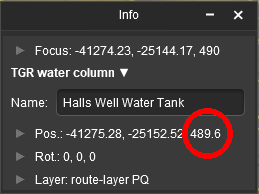 |
|
|
Set the Height of a Scenery Mesh Object
To set the height of a selected scenery mesh object, choose one of the following:-
Options: |
 |
Left Click and Drag Up/Down on the Blue vertical Anchor line. Movement is restricted to the length of the Anchor line only , OR |
 |
Left Click in the Tool Options Palette Height setting and enter a new value (or keep the existing value) then press the Enter key. This works even if the Height icon is not coloured Gold . OR |
 |
Left Click in the Tool Options Palette Height setting and enter a new value (or keep the existing value) then Right Click in the setting box and select the Set Height to Selection option, OR |
 |
select the Apply Height option from the objects Context Menu ( Left Click on the objects Context Icon or press the T key) to apply an existing height value, OR |
 |
in the Info Palette enter a value in the objects z (height) setting or Left Click and Drag Up or Down on the double arrowheads to its right. This can be used to set the height to cm accuracy (see  The Info Palette below). The Info Palette below). |
|
 |
Notes:
|
 |
If multiple objects have been selected then the height of the context object, the one with the Context Icon, will have its height set to the new value. |
 |
All other selected objects will have their heights adjusted to maintain their height relative to that object. For example: If another selected object is 2m below the context object then its adjusted height will always remain 2m below the context object |
|
|
|
|
|
  |
|
|
|
| A selected scenery mesh object, or a group of selected scenery mesh objects, will have a Context Icon that opens a Context Menu. Left Click on the icon or press the T key. The icon design will vary between object types. |
| Scenery Mesh Object Context Menu |
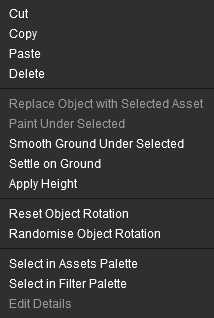 |
| Cut |
remove the selected object or objects from the route and move them into the Scrapbook |
|
| Copy |
copy the selected object or objects and place them into the Scrapbook |
|
| Paste |
paste the contents of the current Scrapbook at the cursor (focus) point |
|
| Delete |
delete the selected objects. It has the same effect as pressing the Delete key |
|
| Replace Object with Selected Asset |
the selected object will be replaced with the asset currently selected in the Assets Palette. If no object has been selected in the Assets Palette or it is the wrong type (e.g. a scenery spline instead of a mesh object) then this option will be greyed out |
|
| Paint Under Selected |
the texture selected in the Assets Palette will be painted under the selected objects. The Tool Options Palette brush settings ( Radius and Sensitivity ) will control how the texture is applied. If no ground texture has been selected in the Assets Palette then this option will be greyed out. |
|
| Smooth Ground Under Selected |
smooths the height of the ground under the selected object to match the set height of the object. The size of the area affected will depend on which has the greater value: the width of the object OR the Tool Options Palette Radius setting. If multiple objects at different heights have been selected then the ground height will be set to match, as far as possible, the heights of each object |
|
| Settle on Ground |
sets the height of the objects to match the height of the terrain beneath them ("drops them back to earth") |
|
| Apply Height |
sets the height of the selected object to the value in the Tool Options Palette Height setting. Where multiple objects have been selected the context object, the one with the Context Icon, will have its height set to the Height value and the other selected objects will have their heights adjusted up or down by the same amount |
|
| Reset Object Rotation |
resets the rotation angle of the objects to their default values |
|
| Randomise Object Rotation |
applies a random Blue Rotation Anchor angle to each object around its vertical axis |
|
| Select in Assets Palette |
highlights the selected object in the Assets Palette |
|
| Edit Details |
opens the Properties window of the selected object. Note: to enter or edit an objects name property use the Info Palette |
|
|
|
Fine Adjustment: Track Objects
|
 |
 |
  |
 |
|
|
 |
Track Objects (signals, switches, speed signs, markers, etc) are always attached to an existing track |
 |
In Surveyor 2.0 they can be moved left, right, above and below the track |
Fine Adjustment: Move a Track Object
|
|
|
  |
|
|
|
 |
Track objects can be dragged to new positions along and beside the track or to a different track |
Fine Adjustment: Set the Height of a Track Object
|
|
|
  |
|
|
|
 |
Track objects can be raised above and lowered below the track level. |
Get the Height of a Track Object
 |
You can copy the height of a selected track mesh object (e.g. a signal) into the Tool Options Palette Height setting. Once it has been copied it can be applied to any other object. |
| |
| Steps: To copy the height of any selected object into the Height setting:- |
 |
Right Click in the Height setting in the Tool Options Palette |
 |
select the Get Height from Selection option |
|
|
Set the Height of a Track Object
Fine Adjustment: Set the Trigger Radius of a Track Object
|
|
|
  |
|
|
|
 |
Certain track objects have a Trigger Radius that sets how close a consist must approach the object to trigger its action |
Track objects that have a Trigger Radius include:-
 |
Track marks such as Track Markers, Priority Markers and Direction Markers |
 |
Track Triggers |
 |
Whistle Signs |
|
 |
It is a good idea to adjust the trigger radius of these objects so that they do not overlap a track junction |
|
|
| The current Trigger Radius of these objects is shown by the size of the "wings" (Red or Green depending on the type of object) attached to the object and, in some cases, a distance value below the name of the object. Both of these options are shown in the image below. |
|
|
|
  |
|
|
|
A selected track mesh object, or a group of selected track mesh objects, will have a Context Icon that opens a Context Menu. The icon design will vary between object types.
To open a selected track objects Context Menu choose one of the following:-
| Options: |
 |
Left Click the Context Icon  OR OR |
 |
Press the T key |
|
|
| Track Object Context Menu |
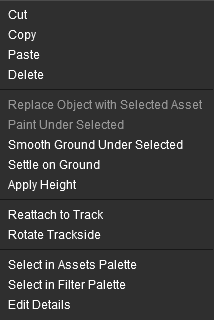 |
 |
Track objects cannot be copied/moved into a scrapbook by themselves. They will be automatically added to a scrapbook by selecting and copying just the track segment under the objects |
| Cut |
remove the selected object or objects from the route and move them into the Scrapbook |
|
| Copy |
copy the selected object or objects and place them into the Scrapbook |
|
| Paste |
paste the contents of the current Scrapbook at the cursor (focus) point
 |
When pasted the track object will include the track and will be surrounded by a wide Marquee Selection Area that, depending on the settings in the  Scrapbook Filters, may replace all other objects, splines, textures, ground terrain and effect layers in that area Scrapbook Filters, may replace all other objects, splines, textures, ground terrain and effect layers in that area |
|
|
| Delete |
delete the selected objects. It has the same effect as pressing the Delete key |
|
| Replace Object with Selected Asset |
the selected object will be replaced with the asset currently selected in the Assets Palette. If the asset selected in the Assets Palette is the wrong type (e.g. a scenery spline) then this option will be greyed out |
|
| Paint Under Selected |
the texture selected in the Assets Palette will be painted under the selected objects. The Tool Options Palette brush settings ( Radius and Sensitivity ) will control how the texture is applied. If no ground texture has been selected in the Assets Palette then this option will be greyed out. |
|
| Smooth Ground Under Selected |
smooths the height of the ground under the selected object to match the set height of the object. For track objects the size of the area affected will depend on the Tool Options Palette Radius setting |
|
| Settle on Ground |
sets the height of the objects to match the height of the terrain beneath them ("drops them back to earth") |
|
| Apply Height |
sets the height of the selected object to the value in the Tool Options Palette Height setting. Where multiple objects have been selected the context object, the one with the Context Icon, will have its height set to the Height value and the other selected objects will have their heights adjusted up or down by the same amount |
|
| Reattach to Track |
if the object has been moved away from the track then it will be reset to its correct position on the track. This option will be greyed out if the object is already attached to the track |
|
| Rotate Trackside |
reverses the position of the object on the track to the other side and facing the opposite direction |
|
| Change Junction Direction |
if the object is a track switch then its switch direction will be reversed |
|
| Select in Assets Palette |
highlights the selected object in the Assets Palette |
|
| Edit Details |
opens the Properties window of the selected rolling stock object. Note: to enter or edit an objects name property use the  Info Palette Info Palette |
|
|
|
 |
Notes:
|
| |
Track objects can be restored to their original height and position (on the track) by opening their Context Menu and choosing one of the following:-
| Options: |
 |
Reattach to Track to cancel the both the height and position changes, OR |
 |
Settle on Ground to cancel the height change only |
|
|
Track objects can also be rotated to the opposite side of the track.
 |
| Steps: To rotate a track object:- |
 |
Open the track objects Context Menu ( Left Click the icon or press the T key) |
 |
Select the option Rotate Trackside |
| Rotating a track object does not change its distance from the track or its height.
|
|
|
Fine Adjustment: Spline Objects (Including Track)
|
 |
 |
  |
 |
|
|
 |
Scenery splines and track splines are defined by their endpoints. Splines are usually added to a route as a series of segments joined at the endpoints. |
Fine Adjustment: Spline Troubleshooting Tip
|
|
|
  |
|
|
|
 |
Quickly Locate Broken Splines and Tracks |
| |
To quickly check for broken links in a spline or track Double Left Click on a segment. All the correctly joined segments upto the next junction or last endpoint (in both directions) will be highlighted. The highlighting will stop at a broken join (which is technically a "last" endpoint) |
|
Fine Adjustment: Moving Splines
|
|
|
  |
|
|
|
| Moving a spline can involve moving one of the following:- |
| Options: |
 |
moving an endpoint, OR |
 |
moving a segment, OR |
 |
moving multiple segments including the entire length of the spline (between junctions) |
|
Fine Adjustment: Move a Spline Endpoint
Fine Adjustment: Move a Spline Segment or Multiple Segments
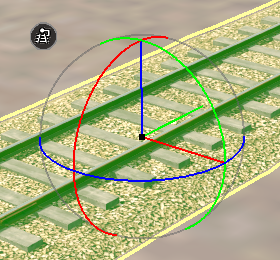 |
The 3D Anchor Frame shown is for a spline segment.
| Steps: To move spline segments:- |
 |
Select the Fine Adjustment Tool. |
 |
Select, Left Click on, the spline segment to be moved.
 |
To select:-
 |
more than one segment - Shift + Left Click on each segment |
 |
ALL the segments - Double Left Click on a segment. This will the select segments in both directions from the segment clicked upto the next junction or the final endpoint |
|
|
 |
Left Click and Drag one of the following:- |
| |
| Options: |
 |
an Anchor Line to move the segment or segments in that specific direction, OR |
 |
anywhere in a segment to move it in any direction in the horizontal plane |
|
|
|
 |
To remove individual spline segments from the selection simply Shift + Left Click on each segment to be removed. |
 |
To remove ALL the segments from a selection, Double Left Click on any highlighted segment OR Left Click anywhere outside the selected segments. |
|
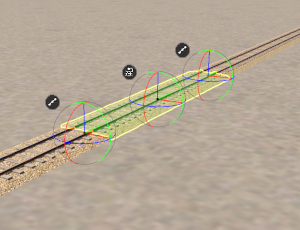 |
Selecting a spline segment with the Fine Adjustment Tool will add a Temporary Endpoint at the point where the segment was clicked.
This will produce 3 Fine Adjustment Tool control frames, one at each end of the segment and one at the click point, as shown in the image on the left. The whole segment can be moved, as shown in the following images, by a Left Click and Drag anywhere within the segment.
 |
A temporary spline endpoint can be made permanent by selecting the Insert Spline Point Here option from its Context Menu |
|
|
 |
 |
a Blue line height change and a Red Anchor rotation can be cancelled at any time (even after saving and reloading the route) by selecting the Settle on Ground option from the segments Context Menu |
 |
a Blue Anchor rotation can be straightened at any time (even after saving and reloading the route) by selecting the Straighten Spline option from the segments Context Menu but this will not return the endpoints to their original positions
|
|
|
Fine Adjustment: Add and Remove Spline Junctions
|
|
|
  |
|
|
|
 |
A junction is formed when three spline segments are joined at an endpoint. Junctions can be formed using non identical but compatible spline objects, such as different types of track splines. |
 |
The Fine Adjustment Tool can be used to form a junction using existing separated splines and endpoints by dragging a terminating endpoint from one spline onto an endpoint between two segments on the other spline. If a new junction is to be formed starting from an existing spline then use the steps below |
|
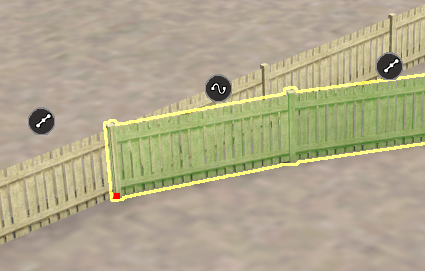 |
| Steps: To add a junction to a spline object:- |
 |
Select the spline object to be used for the junction. The easiest method is hold down the Alt key and Left Click on an existing spline object that you want to use. This will also select the Placement Tool in Step 2 below so you can skip to Step 3 |
 |
Select the Placement Tool from the Tools Palette |
 |
Left Click on the spline at the spot where the junction is to be created. This can be on an existing endpoint or between two endpoints where a new endpoint will be inserted |
 |
move the mouse pointer out from the junction to where the next endpoint of the spline branch will be placed and Left Click |
|
|
| Steps: To remove a junction but keep all its spline segments:- |
 |
use the Fine Adjustment Tool to select ( Left Click on) the junction endpoint |
 |
open the endpoint Context Menu by a Left Click on its Context Icon  or by pressing the T key or by pressing the T key |
 |
select the Separate Splines menu option (this will separate ALL the spline segments that meet at that endpoint) |
 |
 |
A junction can be removed by deleting any spline segment that connects to it |
 |
A junction endpoint can be moved by using the Free Move Tool or the Fine Adjustment Tool |
|
|
|
Fine Adjustment: Add a Track Junction
|
|
|
  |
|
|
|
 |
A track junction is formed using track splines in the same way as described above but track junctions have additional features |
 |
Using Procedural Tracks
If the track object used is a Procedural Track and the junction is formed with another Procedural Track then the junction endpoint dot will be coloured:- |
 |
RED (as shown above) if the junction exceeds the maximum allowed values for a procedural junction. This will not stop the junction from working but it will not display the special features only found in Procedural Tracks, OR |
 |
BLACK if the junction is within the maximum allowed values for a procedural junction and it will display all the Procedural Track special features |
A procedural track junction can be changed from red to black by adjusting the height and/or position (depending on the exact cause of the problem) of the junction endpoint and the endpoints on either side of the junction. See the Wiki Page  How to Use Procedural Track for more details How to Use Procedural Track for more details |
| A junction between two non-procedural tracks and between a procedural track and a non-procedural track will always have a red endpoint dot |
|
Fine Adjustment: Set a Spline Height
|
|
|
  |
|
|
|
Get the Height of a Spline Object
 |
You can copy the height of a spline segment or endpoint into the Tool Options Palette Height setting. Once it has been copied it can be applied to any other object. Choose one of the following:- |
| Options: |
 |
Use the Eyedropper to copy the height of a spline segment
| Steps: To copy the Height of a spline segment (but not an endpoint):- |
 |
hold down the Alt key and move the mouse tool pointer onto the spline segment |
 |
while holding down the Alt key Left Click on the spline segment |
|
 |
 |
When the eyedropper is active spline endpoints will not be visible and cannot be selected |
 |
If the segment has a slope then the height at the point clicked will be copied into the Height setting |
 |
This will also select the clicked object in the Assets Palette and it will become the next object added by a Left Click with the Placement Tool in your Trainz World |
|
|
|
| |
OR |
 |
Use the Height setting drop down menu
| Steps: To copy the Height of a spline segment or one of its endpoints:- |
 |
Left Click on the spline segment or endpoint |
 |
Right Click in the Tool Options Palette Height setting box |
 |
Select the Get Height from Selection option |
|
 |
If the spline segment has a slope then the height at its midpoint will be used |
|
|
|
Set the Height of a Spline Object
To set the height of a selected spline (including track) or endpoint, choose one of the following:-
Options: |
 |
Left Click and Drag Up or Down on the vertical Blue anchor line in the 3D Anchor Frame. OR |
 |
Left Click in the Tool Options Palette Height setting and enter a new value (or keep the existing value) then press the Enter key. This works even if the Height icon is not coloured Gold . OR |
 |
Left Click in the Tool Options Palette Height setting and enter a new value (or keep the existing value) then Right Click in the setting box and select the Set Height to Selection option, OR |
 |
select the Apply Height option from the objects Context Menu ( Left Click on the objects Context Icon or press the T key) to apply an existing height value, OR |
 |
in the Info Palette enter a value in the objects z (height) setting or Left Click and Drag Up or Down on the double arrowheads to its right. This can be used to set the height to cm accuracy (see  The Info Palette below). The Info Palette below). |
|
| Steps: To set the heights of multiple spline segments to the value stored in the Tool Options Palette Height setting:- |
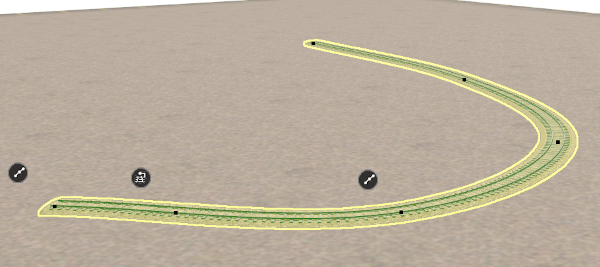 |
 |
Select the spline segments using:-
 |
Shift + Left Click to select individual segments, OR |
 |
Double Left Click to select all the segments up to the next junction (in both directions). |
|
 |
Select one of the options  , ,  , ,  , ,  or or  described above described above |
|
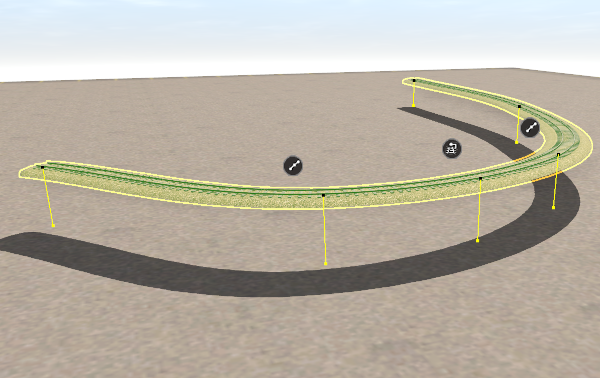 |
ALL the selected spline segments and their endpoints will be set to the specified height. |
|
Fine Adjustment: Set a Spline Gradient
|
|
|
  |
|
|
|
 |
Notes:
|
| |
The Grade is defined as vertical rise divided by horizontal distance converted to a percentage figure. So a grade of 100% (the maximum allowed) would mean a gradient formed by both measurements having the same value (e.g. a rise of 50m over a distance of 50m). A vertical grade, such as a cliff face, would have an infinite grade (cliff height divided by 0) which is currently impossible in Surveyor. |
|
Get the Grade of a Spline Object
 |
You can copy the current Grade of any spline segment into the Tool Options Palette Grade setting. Once it has been copied it can be applied to any other object that has a Grade setting. Choose one of the following:-
Options: |
 |
Use the Eyedropper
| Steps: To copy the Grade of a spline segment (but not an endpoint):- |
 |
hold down the Alt key and move the mouse tool pointer onto the spline segment |
 |
while holding down the Alt key Left Click on the spline segment |
|
 |
When the eyedropper is active spline endpoints will not be visible and cannot be selected. This option will also change the asset selected in the Assets Palette to the object clicked and it will become the next object added by a Left Click with the Placement Tool |
|
The height at the point clicked will also be copied into the Height setting |
| |
OR |
 |
Use the Grade setting drop down menu
| Steps: To copy the Grade of a spline segment or one of its endpoints:- |
 |
Left Click on the spline segment or endpoint |
 |
Right Click in the Tool Options Palette Grade setting box |
 |
Select the Get Grade from Selection option |
|
|
Set the Grade of a Spline Object
|
|
|
  |
|
|
|
A selected scenery spline object, or a group of selected scenery spline objects, will have a Context Icon that opens a Context Menu. The icon design will vary between object types.
| Spline Context Menus |
 Endpoint Context Menu Endpoint Context Menu
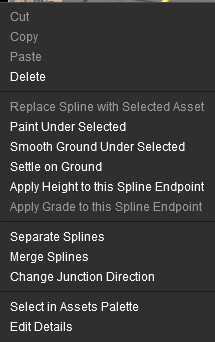 |
  Segment Context Menu Segment Context Menu
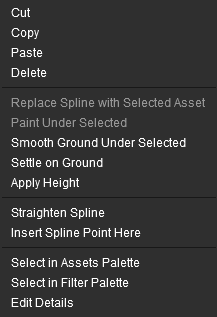 |
|
 |
When copying/moving track segments into a scrapbook any track objects on the segments will be included in the scrapbook |
| Cut |
remove the selected segment or segments from the route and move them into the Scrapbook (  only) only) |
|
| Copy |
copy the selected segment or segments and place them into the Scrapbook (  only) only) |
|
| Paste |
paste the contents of the current Scrapbook at the cursor (focus) point
 |
When pasted from a scrapbook splines will be surrounded by a wide Marquee Selection Area that, depending on the settings in the  Scrapbook Filters, may replace all other objects, splines, textures, ground terrain and effect layers in that area Scrapbook Filters, may replace all other objects, splines, textures, ground terrain and effect layers in that area |
|
|
| Delete |
delete the segment, segments or endpoint. It has the same effect as pressing the Delete key |
|
| Replace Spline with Selected Asset |
the highlighted spline will be replaced with the asset currently selected in the Assets Palette. If the asset selected in the Assets Palette is the wrong type (e.g. a mesh object instead of a scenery spline) then this option will be greyed out (  only) only) |
|
| Paint Under Selected |
the texture selected in the Assets Palette will be painted under the selected objects. The Tool Options Palette brush settings ( Radius and Sensitivity ) will control how the texture is applied. If no ground texture has been selected in the Assets Palette then this option will be greyed out (  only) only) |
|
| Smooth Ground Under Selected |
smooths the height of the ground under the selected spline to match its set height. If multiple spline segments have been selected then the ground under all the segments will be smoothed to their height. The size of the area affected will depend on which has the greater value: the width of the spline OR the Tool Options Palette Radius setting. Does not work for endpoints  |
|
| Settle on Ground |
sets the height of the selected endpoint or segments to match the height of the terrain beneath them ("drops them back to earth"). When used on segments the spline will follow the height changes of the terrain |
|
| Apply Height to this Spline Endpoint |
sets the height of the selected endpoint to the value in the Tool Options Palette Height setting ( only) only) |
|
 | You can copy the Height from an existing spline endpoint into the Height setting of the Tool Options Palette. Once it has been copied it can be applied to any other object.
 hold down the Alt key and Left Click on the spline endpoint to copy its Height value. That value can then be used to set the Height of other spline endpoints hold down the Alt key and Left Click on the spline endpoint to copy its Height value. That value can then be used to set the Height of other spline endpoints |
|
| Apply Height |
sets the height of the selected segment or segments to the value in the Tool Options Palette Height setting (  only) only) |
|
| Apply Grade to this Spline Endpoint |
you must first select a segment then click on one of its endpoint icons  . This sets the height of the endpoint to give a Grade to the surrounding segments that matches the value in the Tool Options Palette Grade setting . This sets the height of the endpoint to give a Grade to the surrounding segments that matches the value in the Tool Options Palette Grade setting |
|
 | You can copy the Grade from an existing spline segment into the Grade setting of the Tool Options Palette. Once it has been copied it can be applied to any other object.
 hold down the Alt key and Left Click on the spline segment to copy its Grade value. That value can then be used to set the Grade of other spline segments hold down the Alt key and Left Click on the spline segment to copy its Grade value. That value can then be used to set the Grade of other spline segments |
|
| Straighten Spline |
forces a straight line (as far as possible) between the endpoints of a single segment. This option will be  ticked if the segment has already been straightened in which case selecting this option will "un-straighten" the segment and remove the tick ( ticked if the segment has already been straightened in which case selecting this option will "un-straighten" the segment and remove the tick (  only) only) |
|
| Separate Splines |
breaks two spline segments into two separate (independent) splines at the selected endpoint ( only) only) |
| Merge Splines |
removes the selected endpoint between two segments and merges the segments into one ( only). Two segments can also be merged by deleting a selected endpoint with the Delete key only). Two segments can also be merged by deleting a selected endpoint with the Delete key |
|
| Insert Spline Point Here |
splits the selected segment into two segments by adding a new endpoint at the point where the segment was clicked (  only) only) |
|
| Select in Assets Palette |
highlights the selected spline object in the Assets Palette |
|
| Edit Details |
opens the Properties window of the selected spline object. This option is only available for Track splines. Note: to enter or edit an objects name property use the Info Palette |
|
|
Fine Adjustment: Rolling Stock Objects
|
 |
 |
  |
 |
|
|
 |
Rolling Stock Objects (locomotives, wagons, etc) can only be moved along the track that they are attached to. If they are moved off the track then they will immediately "snap back" to the nearest track when they are released. |
Fine Adjustment: Move Rolling Stock Objects
|
|
|
  |
|
|
|
Use the Fine Adjustment tool to move a selected rolling stock object along the track.
 |
Rolling Stock Objects are always attached to a track segment. They can be moved along the track or to a different track but they cannot be moved to a position that is to the left, right, above or below the track |
|
 | To move an entire consist of rolling stock objects, Double Left Click on any one of the objects in the consist to select them all and then move them as one object |
|
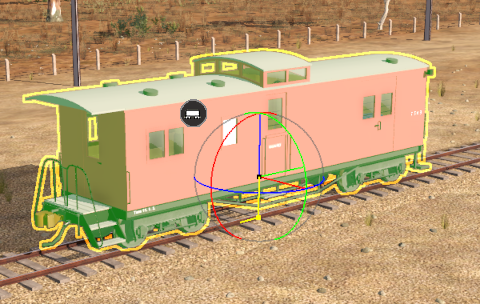 |
 |
Despite their presence in the Fine Adjustment Tool 3D Anchor Frame the Red Green Blue Rotational Anchor lines and the Blue Vertical Anchor Line will NOT work on Rolling Stock Objects |
 |
The Object Anchor (the central black dot) will move the selected rolling stock object or objects in any horizontal direction but they will always be attached to the nearest track spline |
 |
The Green Horizontal Anchor Line will move the selected rolling stock object or objects along the track |
 |
The Red Horizontal Anchor Line will move the selected rolling stock object or objects horizontally off the track but they will always be attached to the nearest track spline |
| Steps: To move a Rolling Stock Object or objects:- |
 |
Left Click and Drag the object or objects |
 |
release the objects on or close to their new track position |
|
|
 |
Notes:
It is possible to place a rolling stock object so that it "overlaps" (occupies the same space as) another rolling stock object. A large yellow X rotating above the rolling stock object is a sign of this "conflict".
This can happen if a rolling stock object is moved off the track and released. It will instantly snap to the nearest track position even if that position is already occupied.
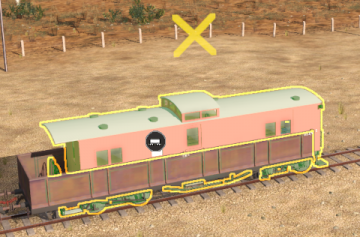
The simple solution is to use the Fine Adjustment Tool to move the incorrectly placed object to an unoccupied section of the track.
|
|
Fine Adjustment: Decouple Rolling Stock Objects
|
|
|
  |
|
|
|
 |
All decoupling operations between Rolling Stock Objects are performed using just a Left Click and Drag. |
 | To decouple a rake of joined rolling stock objects from a consist (for example, the first or last 5 wagons), Shift + Left Click on each of the objects to be selected and then drag them away from the consist |
|
A rolling stock object or objects in the middle of a consist can also be decoupled. This will break the consist into 3 sections.
Fine Adjustment: Couple Rolling Stock Objects
|
|
|
  |
|
|
|
 |
All coupling operations between Rolling Stock Objects can be performed using just a Left Click and Drag or through the objects Context Menu. |
Options:
 Using "Click and Drag" Using "Click and Drag"
Consider the following simple situation:-
 Using the Context Menu Using the Context Menu
Using the same situation as above, the isolated guard van and the gondola wagon at the end of a consist are to be coupled together.
There are two possible outcomes depending on which object has the Context Icon
| Using a more complex example involving multiple objects from several different consists. The selected wagons shown below are to form a single consist based on the loco. |
 |
| The loco was the last object to be selected so it has the Context Icon. The Context Menu is opened and the option Merge into Single Train is selected with the result as shown below. |
 |
| The wagons and loco have been combined into a single consist but not necessarily in a useful order. Left Click and Drag the incorrectly placed vehicles to their correct positions. |
| A selected rolling stock object, or a group of selected rolling stock objects, will have a Context Icon that opens a Context Menu. The icon design will vary between object types. |
To open a selected rolling stock object's Context Menu choose one of the following:-
| Options: |
 |
Left Click its Context Icon  OR OR |
 |
Press the T key |
|
|
|
 |
You cannot add rolling stock assets to a Scrapbook but you can create and save Consist Assets that have multiple rolling stock objects
| Steps: To create a Consist Asset:- |
 |
select the consist - Double Left Click on the consist or Shift + Left Click on individual items |
 |
open the consist Context Menu - Left Click on its icon or press the T key |
 |
select the option Save to Consist Asset... |
 |
enter a name and an optional description for your new Consist Asset and click the  icon icon |
| The consist will appear as a Train Asset in the Assets Palette |
|
|
|
Fine Adjustment: Object Height Problem Solutions
|
 |
 |
  |
 |
|
|
| Two Anchor Points on the Blue vertical Anchor line determine the height of an endpoint or an object above the ground. |
 |
the Object Height Anchor, which is normally Black but turns Green when it is selected, controls the height of the object (including spline Endpoints) above the ground. This Anchor point can be moved vertically by the tool pointer using the Blue vertical Anchor line |
 |
the Ground Height Anchor, which is Yellow, marks the position of the object on the ground. This Anchor point cannot be moved vertically by the tool pointer but its height can be changed by setting the Tool Options Palette Height value |
| It is common for both height anchors to be at the same height but there are many situation where the two will be at different heights. The examples below show situations where the two are at different heights and the height of the Object Height Anchor will need to be adjusted. |
|
 |
Notes:
The height of a Rolling Stock Object (locomotive, wagon, etc) CANNOT be altered. These objects are always tied to the height of the track where they have been placed. |
|
A more complex alternative method is to use the Surveyor Compass Rose, the Info Palette and the Tool Options Palette.
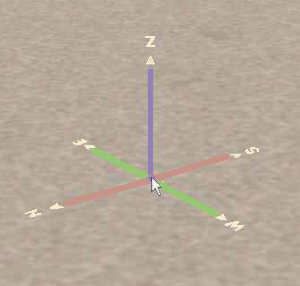
The Surveyor Compass Rose |
| Steps: Use the Compass Rose:- |
 |
Right Click on the terrain at a point which has the height that will be used by the object. This will position the Surveyor Compass Rose and record its data as the Focus |
 |
Open the Focus controls in the Info Palette by a Left Click on the small Right Arrowhead to the left of the Focus label |
|
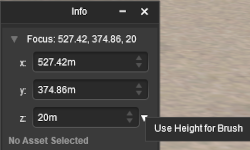 |
The Info Palette stores the positional data, including the Height (the z value), of the Compass Rose under the label Focus |
|
 |
Left Click on the white Down Arrowhead next to the z value and select the menu option Use Height for Brush . This will transfer the Focus z value to the Tool Options Palette Height setting |
 |
Open the Context Menu for the object (or spline endpoint) |
 |
Select the option Apply Height or Apply Height to this Spline Endpoint |
|
|
 |
Keyboard Shortcut: F |
|
|
Some features of this tool use the Scrapbook Palette, Assets Palette and Tool Options Palette. If these palettes are not visible on the screen then refer to  Notes: Palettes at the top of this document. Notes: Palettes at the top of this document.
|
|
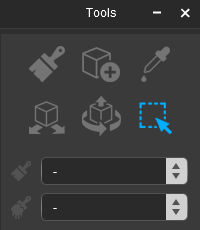 |
| Tool Targets The Marquee Tool has no Target options so it has no drop down menu list |
| This tool has a range of tasks:- |
 |
Select objects for moving, deleting and copying into a scrapbook |
 |
Add and delete one or multiple baseboards |
 |
Set the grid resolution of one or multiple baseboards |
 |
Set the texture and height of an area including multiple baseboards |
|
| Tool Actions The Marquee Tool has no Action options so it has no drop down menu list |
|
|
 |
The Marquee Tool draws out a rectangular area, the Marquee Selection Area, on the route. Any objects (including ground heights, ground textures and TurfFX/Clutter Effect Layers) that are inside the Marquee Selection Area or touched by its boundary will be selected. |
| Steps: To draw out a Marquee Selection Area:- |
 |
select the Marquee Tool from the Tools Palette (or press the F key) |
 |
Left Click and Drag over the area to be selected |
|
|
 |
You can use the Assets Palette filters to restrict the objects that will be selected in the Marquee Selection Area. See  Marquee Assets Filter below for more details Marquee Assets Filter below for more details |
|
|
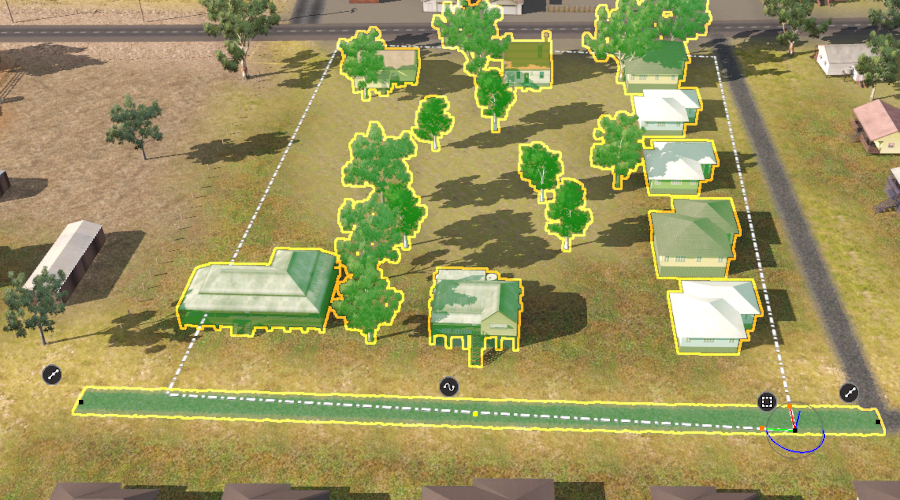
| In the image above:- |
 |
a road spline at the bottom and a house at the lower left of the Marquee Selection Area have been touched by the drawn rectangle so they have been included in the selection. |
 |
the Marquee Selection Area was drawn from the top left to the bottom right which places the Marquee Context Icon  at the bottom right of the rectangle. at the bottom right of the rectangle. |
 |
the bottom right of the Marquee Selection Area also has a 3D Anchor Frame.
 |
Like the Fine Adjustment Tool, a Marquee Selection Area has a 3D Anchor Frame. The Marquee Anchors are used to move and rotate the objects within the selection area (including ground heights, ground textures and TurfFX/Clutter Effect Layers) through 3D space |
|
|
 |
The road spline was the last object that was included in the selection area so its Context Icons are also present. |
| Not shown in the image, because they are not highlighted, are the Ground Heights, Ground Textures and Effect Layers that are also included in the Marquee Selection Area. |
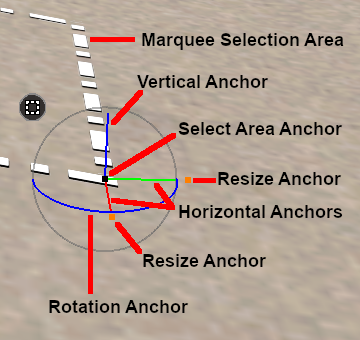 |
The Marquee Selection Area 3D Anchor Frame has some similarities to the one used with the Fine Adjustment Tool.
 |
the Green and Red horizontal Anchors will move the Marquee and all its contents horizontally in the Anchor direction |
 |
the Blue vertical Anchor will move the Marquee with all its contents up or down in the Anchor direction |
 |
the Blue rotational Anchor will rotate the Marquee with all its contents in the direction of the rotation movement |
 |
there are no Green and Red rotational Anchors |
 |
at the centre of the 3D Anchor Frame is a Select Area Anchor. Left Click and Drag this Anchor point to move the Marquee with all its contents in any horizontal direction |
 |
each of the Green and Red horizontal Anchors has a resize Anchor, an orange coloured dot, located at its end. Left Click and Drag these Anchor points to resize the Marquee Selection Area (and its contents) in that specific direction. Objects that are in locked layers will not be affected by the resize action |
|
The Marquee Tool and the Assets Palette Filter
|
 |
 |
|
 |
|
|
 |
The Assets Palette filter tools can be used to restrict the objects selected by the Marquee Tool. |
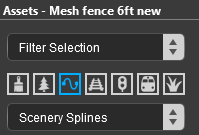 |
| Steps: To restrict the objects selected by the Marquee Tool:- |
 |
set the Filter Type in the Assets Palette to Filter Selection |
 |
set the other filter options in the Assets Palette to narrow down the type of objects (e.g. Scenery Splines and/or enter a partial name in the Text Box) |
 |
select the Marquee Tool from the Tools Palette (or press the F key) |
 |
Left Click and Drag out the Marquee Selection Area around the objects to be selected |
| Only those objects identified in the Assets Palette filters will be selected by the Marquee |
|
|
 |
Notes:
|
|
| The Marquee Anchors will move:- |
 |
the selected scenery objects. If the objects are in locked layers then they will NOT be moved |
 |
the ground textures. As shown in two of the images below this will leave the original baseboard ground texture or grid pattern showing |
 |
the TurfFX/Clutter Effect Layers. If an effect layer is locked then it will not be moved but it will still be deleted from the area that was covered by the original Marquee Selection Area |
 |
the ground heights |
|
 |
If you do not want to move everything that is in the Marquee Selection Area then use the Asset Filters before using the Marquee Tool to only include those assets that you do want to move |
|
|
| The following images demonstrate the effect of using the Marquee Anchor Controls on the image shown at the top of this section as the starting point. |
Horizontal Anchor Shift
| |
The Green horizontal Anchor has been used to shift the Marquee Selection Area to the left. Note that the 3 trees and a small building that were on the left of the Marquee Selection Area in the image above have been replaced (overwritten) by the Marquee contents. Also note that the texture has been moved leaving a gap showing the original grid texture. |
|
| |
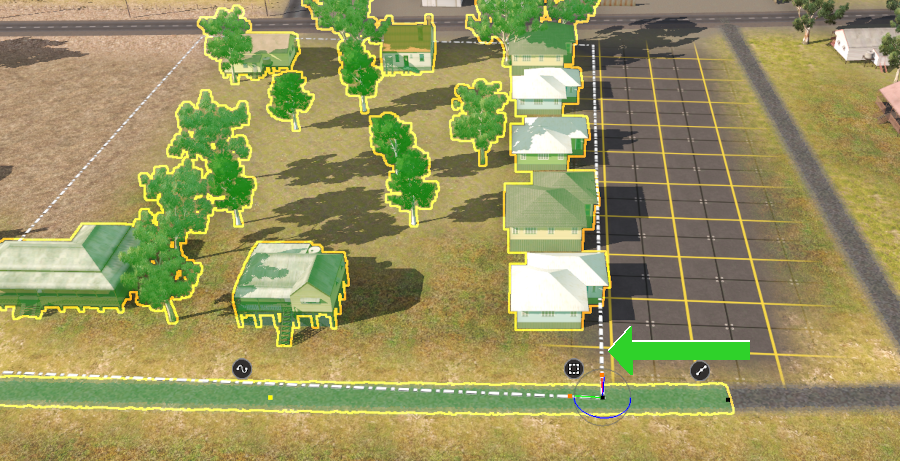 |
| |
|
Rotational Anchor Shift
| |
The Blue rotational Anchor has been used to rotate the Marquee Selection Area about 45° anti-clockwise. Again, anything that was originally in the area now covered by the Marquee Selection Area has been replaced by the contents of the Marquee. Also note that the texture has been moved leaving a gap showing the original grid texture. |
|
| |
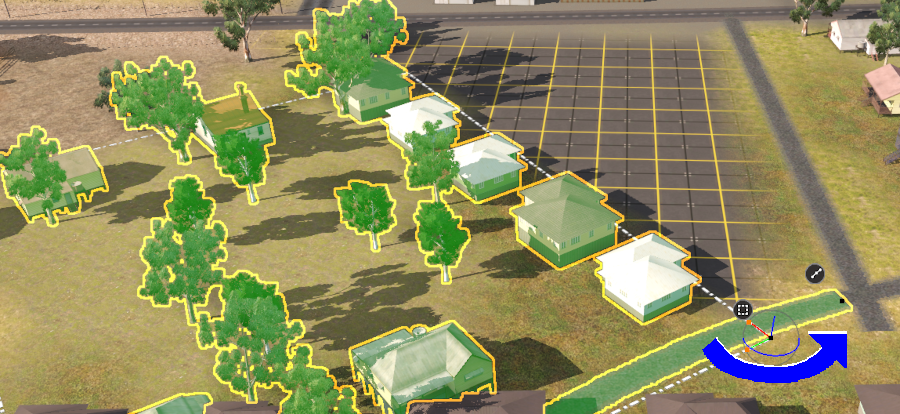 |
| |
|
Vertical Anchor Shift
| |
The Blue vertical Anchor has been used to lift the Marquee Selection Area upwards |
|
| |
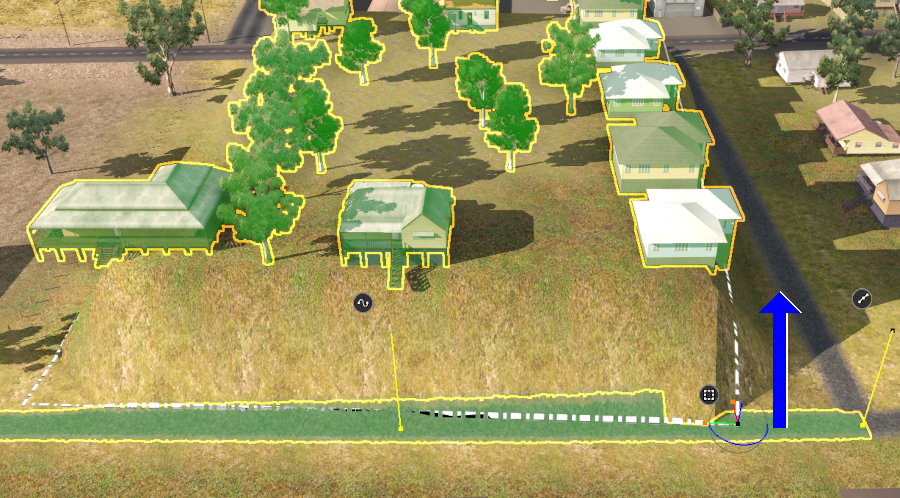 |
| |
|
 |
Notes:
|
| Scrapbooks, when created, will contain:- |
 |
Ground Heights |
 |
Ground Textures |
 |
TurfFX/Clutter Effect Layers - if present |
 |
Selected Objects - scenery items, splines, track, signals, etc |
| But NOT Rolling Stock (Trains)
|
| The ground heights, ground textures and TurfFX/Clutter Effect Layers in the Marquee Selection Area will always be added to the scrapbook. You can use the Asset Palette Filters to control which visible objects in the selection area will also be added |
|
|
 |
Notes:
|
|
Scrapbooks, when painted or pasted, can contain any combinations of:- |
 |
Ground Heights |
 |
Ground Textures |
 |
TurfFX/Clutter Effect Layers |
 |
Scenery Objects (Meshes) - individual buildings, trees, signals, etc |
 |
Scenery Splines - roads, track, fences, etc |
You have options in  The Scrapbook Filters that will control which of these data types are added to your Trainz World and how they are added. The Scrapbook Filters that will control which of these data types are added to your Trainz World and how they are added. |
|
|
Once an area has been marked out by the Marquee Tool a number of options become available.
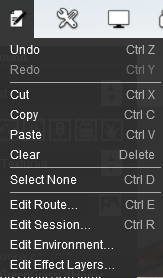 |
The  Surveyor Edit Menu will show some additional options specifically for the Marquee Tool:- Surveyor Edit Menu will show some additional options specifically for the Marquee Tool:- |
| Cut |
the objects selected in the Marquee area (including the ground heights, ground textures and TurfFX/Clutter Effect Layers) will be copied and placed into a new Scrapbook. Any scenery objects (excluding ground heights, ground textures and effect layers) that are not in a locked layer will be removed from the Marquee area. This is the same as pressing the Ctrl + X keys |
| Copy |
the objects selected in the Marquee area (including ground heights, ground textures and TurfFX/Clutter Effect Layers) will be copied and placed into a new Scrapbook. This is the same as pressing the Ctrl + C keys |
| Paste |
the contents of the current Scrapbook will be pasted into the route at the cursor (focus) point. Which contents will be pasted and how they will be pasted are controlled by the Filters in the Scrapbook Palette (see  Scrapbook Data for more details). This option will always be available with and without a Marquee area being marked if there is a scrapbook available to be pasted. This is the same as pressing the Ctrl + V keys Scrapbook Data for more details). This option will always be available with and without a Marquee area being marked if there is a scrapbook available to be pasted. This is the same as pressing the Ctrl + V keys |
| Clear |
the selected scenery objects that are not in locked layers will be removed from the Marquee area but NOT the selected ground heights, ground textures and TurfFX/Clutter Effect Layers. This is the same as pressing the Delete key |
| Select None |
the Marquee Selection Area boundary lines are removed from the route cancelling the selection process. Nothing that is inside the area will be removed. This is the same as pressing the Ctrl + D keys |
|
|
Adding a New Scrapbook
|
|
|
  |
|
|
|
 |
The Cut and Copy Scrapbook operations are also found in the Marquee Context Menu (see the Marquee Context Menu section above). |
 | You don't have to use the Marquee Tool to create a new Scrapbook. You can use the Free Move Tool or the Fine Adjustment Tool to select any number of objects and then press Ctrl + C . The selected objects, along with the ground heights, ground textures, and any TurfFX/Clutter Effect Layers, will be copied into a new Scrapbook |
|
When a new Scrapbook is created by a Cut (or press Ctrl + X ) or Copy (or press Ctrl + C ), it will appear in the Scrapbook palette with some basic details.
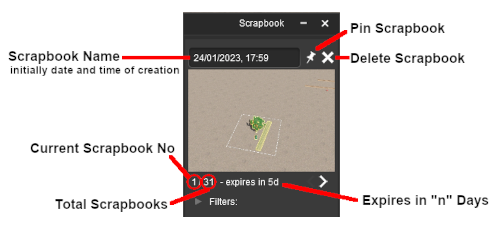 |
| The newly created scrapbook will be given:- |
 |
a name consisting of the date and time of its creation |
 |
a thumbnail |
 | The thumbnail image will be taken using the current camera POV (point of view). To get a better image adjust the camera position and view to give the best possible shot of the Scrapbook objects before giving the Cut or Copy command
|
|
|
 |
a scrapbook number (it will be inserted as the №1 scrapbook) |
 |
an expiry date which will be set 5 days after its creation - this will countdown each day until 0 when the new scrapbook will be deleted |
|
 |
Notes:
|
 |
Scrapbooks use very little memory so there is no real limit to how many you can store in the palette but finding the one you want will be more difficult as the list grows longer |
 |
Rolling Stock Objects cannot be added to a Scrapbook. The rolling stock Context Menu option Save to Consist Asset... performs some of the Scrapbook functions for rolling stock objects and consists |
 |
Deleting a Scrapbook after it has been pasted does not delete the objects that it has added to the route |
|
|
There are two changes that can be made to the new scrapbook:-
 |
Give it a name - Left Click inside the Name Text Box and type a new name. To set its new name Left Click on the image OR press the Enter key |
 |
Make it permanent - Left Click the white Pin icon ( ) to change it to blue. The scrapbook will no longer expire but it can still be deleted at any time ) to change it to blue. The scrapbook will no longer expire but it can still be deleted at any time |
Pinned scrapbooks are always shown with a blue pin icon  and the words "pinned, no expiry" displayed next to their scrapbook № and the words "pinned, no expiry" displayed next to their scrapbook № |
 | The Pinning of any scrapbook can be reversed so that it will then expire in 5 days time. Left Click the blue pin icon. |
|
|
|
 |
Once a scrapbook has been Pinned it becomes an asset and will appear in Content Manager

The scrapbook can be uploaded to the DLS and saved as a CDP file.
 | You can archive your scrapbooks as CDP files to keep the number of installed scrapbooks to a minimum. If an archived scrapbook is needed then you can use the Import Content Files option in Content Manager to add it to the Scrapbook Palette. It can be deleted from the palette later, when no longer needed. |
|
 |
The Marquee Context Menu creates, deletes, converts and paints individual or multiple baseboards. It also creates and pastes scrapbooks. |
To open the Context Menu for a Marquee Selection Area Left Click on its Context Icon  or press the T key. or press the T key.
| Marquee Context Menu |
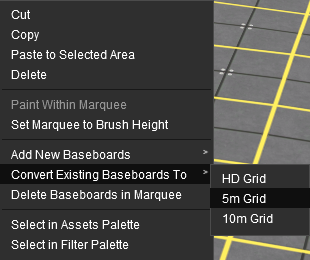 |
| Cut |
removes the objects in the selection area from the route and moves them into the Scrapbook. Ground heights, ground textures and TurfFX/Clutter Effect Layers will be copied, not cut. Has the same effect as pressing the Ctrl + X keys |
|
| Copy |
copies the objects in the selection area and moves them into the Scrapbook. Has the same effect as pressing the Ctrl + C keys |
|
| Paste to Selected Area |
pastes the objects in the currently selected Scrapbook into the selection area. Which objects are pasted and how they are pasted is controlled by the settings in the Scrapbook Filter. Has the same effect as pressing the Ctrl + V keys |
|
| Delete |
deletes the objects in the selection area except for the ground heights, textures and effect layers. Has the same effect as pressing the Delete key |
|
| Paint Within Marquee |
if a texture has been selected in the Assets Palette then that texture will be painted inside the selection area using the settings in the Tool Options Palette. If no texture has been selected then this option will be greyed out |
|
| Set Marquee To Brush Height |
changes the ground height of the selection area to the brush height in the Tool Options Palette |
|
| Convert Baseboards To |
converts the grid of the entire baseboard or baseboards covered by the selection area into the resolution selected from the three options - HD Grid (in Trainz Plus only), 5m Grid and 10m Grid . If the selection area covers any empty spaces outside the existing baseboards then new baseboards will be created using the ground height in the Tool Options Palette. See Notes: below |
|
| Delete Baseboards in Marquee |
deletes the entire baseboard or baseboards covered by the selection area. See Notes: below |
|
| Select in Assets Palette |
identifies and selects in the Assets Palette the most common ground texture used in the selection area |
|
|
|
 |
Notes:
|
| |
 |
The Convert Baseboards To and Delete Baseboards in Marquee options will affect the entire baseboard or baseboards that contain the Marquee Selection Area even if the selection area only covers a small part of a baseboard.
|
 |
It is NOT RECOMMENDED that you mix HD Grid baseboards (in Trainz Plus only) with 5m Grid or 10m Grid baseboards in the same route. The boundaries between HD and non-HD baseboards will have display issues. If you are going to use the HD Grid terrain then it is recommended that the entire route should be Upgraded to HD Grid. See  Upgrading a Route to HD below for more details. There is no problem with mixing 5m and 10m grid baseboards in the same route Upgrading a Route to HD below for more details. There is no problem with mixing 5m and 10m grid baseboards in the same route |
|
|
 |
The Marquee is a powerful tool for adding, deleting and changing the properties of multiple baseboards |
Add, Delete, Convert Baseboards
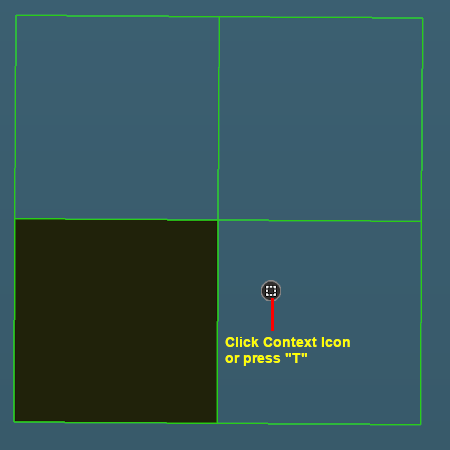
 |
In Trainz Plus you can Upgrade an existing 5m or 10m resolution route entirely to HD. See  Upgrading a Route to HD below for more details. Upgrading a Route to HD below for more details. |
|
|
| Steps: To add, delete and convert baseboards:- |
 |
select the Marquee Tool (or press the F key). |
 |
Left Click and Drag to draw out the Marquee Selection Area area where the new baseboards will be added or the existing baseboards will be deleted or converted. |
| The Marquee Selection Area, shown with a green border in the image on the left, covers the existing baseboard (black, bottom left) and where 3 new baseboards will be created. The Marquee has a Context Icon as shown in the image. |
 |
Left Click on the Context Icon or press the T key to open up the Marquee Context Menu (see Marquee Context Menu above). |
 |
Create, Convert, Delete |
 |
To Add new baseboards select the context option Add New Baseboards > then select a resolution from two or three sub-options, HD Grid (in Trainz Plus only), 5m Grid and 10m Grid . If existing baseboards have also been selected then they will NOT be converted to the new resolution.
 |
It is NOT RECOMMENDED that you mix HD Grid baseboards (in Trainz Plus only) with 5m Grid or 10m Grid baseboards in the same route. It should be ALL HD or none. There is no problem with mixing 5m and 10m grid baseboards in the same route |
|
|
 |
To Convert selected baseboards to a different Grid Resolution select the context option Convert Existing Baseboards To > then select a resolution from two or three sub-options, HD Grid (in Trainz Plus only), 5m Grid and 10m Grid . If empty spaces with no baseboards have been selected then new baseboards will NOT be created in those spaces.
 |
It is NOT RECOMMENDED that you mix HD Grid baseboards (in Trainz Plus only) with 5m Grid or 10m Grid baseboards in the same route. It should be ALL HD or none. There is no problem with mixing 5m and 10m grid baseboards in the same route |
|
|
 |
To Delete the selected baseboards select the context option Delete Baseboards in Marquee . Note: An entire baseboard will be deleted even if the selection area only covers a small part of the baseboard. The Ctrl + Z keys can Undo the deletion.
|
|
|
Baseboard Ground Height
|
|
|
  |
|
|
|
 |
The Marquee Selection Area can be used to set the height of entire baseboards or just a selected section of one or more baseboards |
| Steps: To set the height of the baseboards or area under the Marquee Selection Area:- |
 |
set the required ground height in the Tool Options Palette Height setting. Note: the Grade setting has no effect when used with the Marquee tool. |
 |
select the Marquee Tool (or press the F key). |
 |
Left Click and Drag to draw out the Marquee Selection Area area so that it covers the area that will have its height set. This can include multiple baseboards or empty spaces where new baseboards will be created at the new height. |
 |
Left Click on the Context Icon or press the T key to open up the Marquee Context Menu (see Marquee Context Menu above). |
 |
select the Context Menu option Set Marquee to Brush Height . If the Marquee extends over empty space then new baseboards will be created at the set Height value. |
|
Baseboard Ground Texture
|
|
|
  |
|
|
|
 |
The Marquee Selection Area can be used to set the ground texture of entire baseboards or just a selected section of one or more baseboards |
| Steps: To paint the baseboards or area under the Marquee Selection Area with a ground texture:- |
 |
select a ground texture from the Assets Palette |
 |
set the brush Scale and any other required controls in the Tool Options Palette. |
 |
select the Marquee Tool (or press the F key). |
 |
Left Click and Drag to draw out the Marquee Selection Area area so that it covers the area that will be painted with the texture. This can include multiple baseboards and empty spaces where new baseboards will be created with the selected texture. |
 |
Left Click on the Context Icon or press the T key to open up the Marquee Context Menu (see Marquee Context Menu above). |
 |
select the Context Menu option Paint Within Marquee . If the Marquee extends over empty space then new baseboards will be created and covered with the selected ground texture. The new baseboards will be created at the Default altitude for the set Region or at 0m if no region has been set. |
|
Mass Object Moves and Clones
|
 |
 |
 |
 |
 |
 |
 | Both the Free Move Tool and the Fine Adjustment Tool can move and clone (copy) single and multiple objects. The Marquee Tool can also move and clone objects but it will include the ground heights, ground textures and any TurfFX/Clutter Effect Layers in the cloning and moving operations.
|
|
Selecting and Moving Multiple Objects
|
|
|
  |
|
|
|
Multiple objects can be selected and moved with the Free Move Tool and the Fine Adjustment Tool.
 |
Notes: Mass Moves
| The objects do not have to be:- |
 |
the same type. They can be a mixture of scenery splines and mesh objects |
 |
in the same layers but objects in Locked layers cannot be moved |
|
|
|
 | You can also use the Marquee Tool to move objects but this will also move the ground heights, ground textures and TurfFX/Clutter Effect Layers as well as objects. |
|
|
Selecting Multiple Identical Objects
|
|
|
  |
|
|
|
You can quickly select all nearby identical objects by a Double Left Click on an object.
 | This also applies to all the wagons in a consist. Double Left Click on any one of them to select all of them - they do not have to be identical wagons. |
|
| A forest of many different trees. Only one has been selected. |
Double Left Click on a tree to select all the identical trees in the forest. |
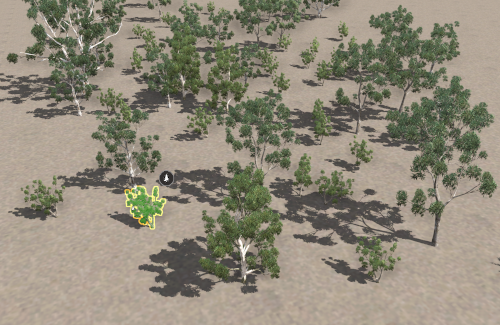 |
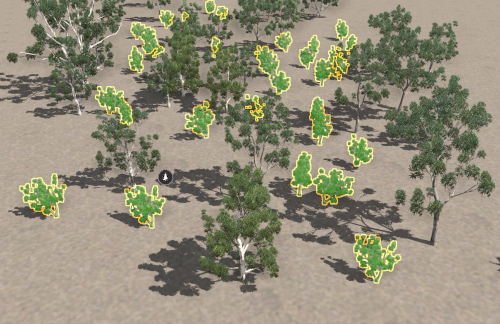 |
 | Shift + Double Left Click on another object. It and all its identical copies will be added to the selection. |
|
 |
You can easily clone single and multiple selected objects. If you have selected a group of objects they do not have to be the same type - you can select scenery objects and scenery splines. |
 |
Notes: Layers and Cloning
|
 |
the objects can be in different layers |
 |
the layers can be locked and the objects will still be cloned |
 |
all the cloned objects will be placed into the current Active Layer which must be Unlocked |
For more information on layers see  The Info Palette at the end of this document. The Info Palette at the end of this document. |
|
|
| Steps: To clone an object or a group of objects:- |
 |
use either the Free Move Tool or the Fine Adjustment Tool to select the object or objects |
 |
Ctrl + Left Click and Drag on any of the selected objects |
|
|
Upgrading a Route to HD (Trainz Plus Only)
|
|
 |
 |
 |
 |
 |
 |
This option is only available in Trainz Plus |
 |
Upgrading an entire route to HD is recommended over mixing HD Grid and non-HD Grid baseboards in the same route, but there are limitations to upgrading that must be considered beforehand |
| You can convert (Upgrade) an entire 5m Grid or 10m Grid route to HD Grid in a single step but there are some important limitations. See the Notes: below. |
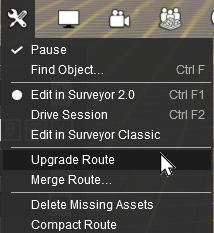 |
| Steps: To Upgrade a route to HD:- |
 |
Left Click on the  Surveyor Tools Menu icon Surveyor Tools Menu icon |
 |
Left Click on the option Upgrade Route |
| A progress bar will show the status of the conversion process which may take several minutes depending on the size of the route. At the conclusion of the upgrade you will be given a report indicating that the process was successful or it has failed because of errors. See Notes: below. |
|
|
|
If the Info Palette is not visible on the screen then refer to  Notes: Palettes at the top of this document. Some Info Palette functions will also require the Assets Palette and the Tool Options Palette. Notes: Palettes at the top of this document. Some Info Palette functions will also require the Assets Palette and the Tool Options Palette.
|
|
| This palette can be easily overlooked but it has some very useful features:- |
 |
naming objects |
 |
providing precise data and control over the "focus" - the position of the cursor |
 |
providing precise data and control over the position and orientation of objects (it can be used instead of the Free Move Tool and the Fine Adjustment Tool) |
 |
identifying and setting the "home" layer and binding layer of a selected object |
 |
used for locking and unlocking a selected objects layer |
The components of the Info Palette are identified in the image below.
All the Focus, Position and Rotation settings have drop down menus that allow values to be transferred to and from other settings and other tools.
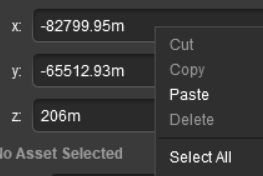
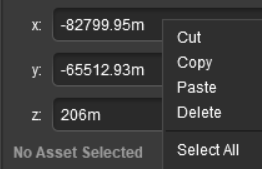 |
| Steps: |
 |
Right Click inside an Info Palette setting box |
| The first time the popup menu is opened it will only show two active options - Paste and Select All. |
| Paste |
will paste the contents of your Operating System (Windows, MacOS) clipboard into the setting. If data is already present then the new data will be added to it, not replace it |
|
| Select All will highlight the contents of the selected setting. You can also achieve this with a Left Click and Drag across the contents of the setting |
|
 |
Right Click inside the same Info Palette setting box |
| Once the value in a setting has been selected (highlighted) the popup menu will show all options as active. |
| Cut |
will copy the contents of the selected setting into your Operating System clipboard. The contents will then be deleted from the setting |
|
| Copy |
will copy the contents of the selected setting into your Operating System clipboard without deleting it |
|
| Delete will delete the contents of the selected setting. You can also achieve this with a Left Click and Drag across the contents and then press the Delete key |
|
|
|
Next to the z co-ordinate in both the Focus and Position is a small white down arrowhead. Left Click on the arrowhead to open its menu.
 |
There is only one option in the sub-menu.
| Left Click on the Use Height for Brush option to copy the current z value to the Tool Options Palette Height setting. |
|
|
 |
The Focus shows the current position and height of the Cursor object. |
Open up the Focus by a Left Click on its arrowhead icon.
 | Before changing the cursor position with the Focus controls, set a Bookmark at its current position.
|
|
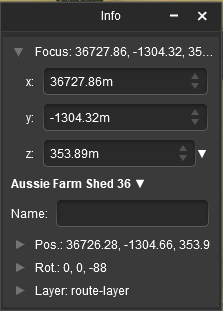 |
The current cursor position is shown in the x, y and z text boxes. These values can be edited to move the cursor to a new position but CARE will be needed.
 | On the right of each data entry box is a pair of Up/Down arrow controls. Left Click and Drag up or down on these to adjust the position in smaller increments down to centimetres |
|
 |
Notes:
If you enter an x or y value that is "out in empty space" (beyond the edge of a boundary baseboard) then the cursor will be refocused at a point on the baseboard edge that is the closest to the entered co-ordinates.
|
|
|
 |
If it has not been deleted you can identify the North-West corner of the original (first) baseboard by entering 0 as the Focus x and y co-ordinates |
|
 |
"Asset Name" refers to the name of the asset as displayed in the Assets Palette and in Content Manager. This is not the same as the Object Name (see the next section) |
You must have an object (or objects) selected for an Asset Name to be shown and for this menu to be available.
 |
If more than one object has been selected then the name and position data shown will be for the last selected object. If different objects (with different kuid codes) have been selected then a count of the additional objects will be added. The (+2) shown in the object name in the image on the left indicates that 2 additional different objects are in the group of selected objects. |
Next to the Asset Name is a small white Down Arrowhead. Left Click on the arrowhead to open its menu.
 |
| Asset Name Menu Options |
| Copy |
NOT WORKING (a known bug) |
|
| Show Asset Details |
opens a new window showing the image and description of the selected object |
|
| List Assets in New Window |
opens up Content Manager and lists all the selected objects |
|
| Add to Picklist |
adds selected objects to a Picklist |
|
| Remove from Picklist |
removes selected objects from a Picklist (objects must already be in a Picklist) |
|
| Select in Assets Palette |
selects and highlights the selected object in the Assets Palette |
|
|
|
 |
"Object Name" refers to the name that you give to an object |
| You can give any object in your route an identifying name. In some cases a name is vital for AI and session operations, in other cases it will be needed as a display feature - for example: to be shown on a station nameboard. You must have an object (or objects) selected for this option to be available. If more than one object has been selected then only the last object (the one with the Context Icon) will be affected |
 |
| Steps: To name (or rename) a selected object:- |
 |
Left Click inside the Name text entry box |
 |
Enter a name |
 |
Press the Enter key |
|
|
 |
| There is no ban on two or more objects using the same name |
|
In the image shown on the left there are 4 objects all named Old Orroroo Rd.
This will not cause any problems for scenery objects apart from finding the exact one you want with the Finder Tool ( Ctrl + F keys).
 |
Notes:
However, duplicated names will cause problems for Industries (including passenger enabled stations), Locomotives, Track Marks, Triggers, Switches, Signals, etc that have to be identified to control the operation of a session. |
| These objects must have unique names |
|
|
Position Info and Controls
|
 |
 |
|
 |
|
|
You must have an object (or objects) selected for the position data to be shown and edited. Open up the position data by a Left Click on its Pos: arrowhead icon.
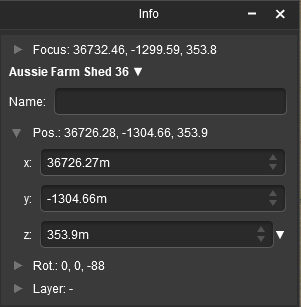 |
The position of the selected object (or the last object if more than one is selected) is shown in the x, y and z text boxes. These values can be edited to move the object or objects to a new position but CARE will be needed.
 | On the right of each data entry box is a pair of Up/Down arrow controls. Left Click and Drag up or down on these to adjust the position in smaller increments down to centimetres |
|
 |
Notes:
If you enter an x or y value that is "out in empty space" (beyond the edge of a boundary baseboard) then the objects will be moved to that position and may vanish from view. The Undo command can be used to reverse the move or the Marquee Tool can be used to add a baseboard under the "floating" objects. |
|
|
Rotation Info and Controls
|
 |
 |
|
 |
|
|
You must have an object (or objects) selected for the rotation data to be shown and edited. Open up the rotation data by a Left Click on its Rot: arrowhead icon.
You must have an object (or objects) selected for the layer data to be shown and edited. Open up the layer data by a Left Click on its Layer: arrowhead icon.
 |
Notes:
|
 |
the Info Palette is best used to show and edit the layer and binding layer assignments of individual selected objects |
 |
operations such as creating, deleting, merging, renaming, moving and hiding layers are performed using the Layers Palette |
 |
layers can be Locked and Unlocked using the Info Palette but the Layers Palette is often the best choice for these tasks |
|
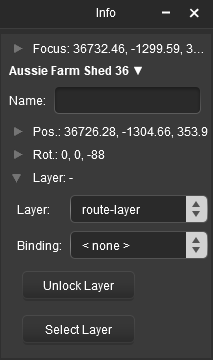 |
This will show the:-
 |
current layer assigned to the selected object |
 |
its assigned Binding Layer (if any) |
 |
the Locked or Unlocked state of the assigned layer |
| |
 Layer is currently Unlocked. Click this button to Lock the layer Layer is currently Unlocked. Click this button to Lock the layer |
| |
 Layer is currently Locked. Click this button to Unlock the layer Layer is currently Locked. Click this button to Unlock the layer |
| |
Using this button will also change the Locked or Unlocked padlock icon shown next to the layer name in the Layers Palette
 |
 |
Notes:
 |
Objects in a Locked Layer cannot be deleted or moved |
 |
Locked Layers can be deleted, moved and merged with other layers |
|
|
|
|
|
Assigning Objects to a Different Layer
|
 |
 |
|
 |
|
|
 |
The Active Layer is the layer used by the Placement Tool when objects are added to your Trainz World. |
A selected object or group of selected objects can be assigned to a different layer. If multiple objects have been selected then they do not have to all be in the same layer.
 | You can also set the Active Layer by selecting its name from the list in the Layers Palette. |
|
| Options: To set current layer to the Active Layer:- |
 If the Select Layer button is greyed out If the Select Layer button is greyed out |
 |
then the selected object is now assigned to the current Active Layer so there is no need to use this option |
 If it is NOT greyed out If it is NOT greyed out |
 |
then the selected object is now assigned to a layer that is not the current Active Layer. Left Click on the Select Layer button to switch the Active Layer to the same layer as the object
|
|
Assigning Objects to a Binding Layer
|
|
 |
|
 |
|
|
 |
The Binding Layer, or Bound Layer as it is also called, is a tool used in the development of a route or session. It allows you to temporarily assign an object to a second layer while it is still in its original layer. The object will then take on the properties (Locked or Unlocked, Hidden or Visible) of both layers. |
Assigned
Layer |
|
Binding
Layer |
|
Object
Status |
|
 Unlocked Unlocked |
 or None or None |
 Unlocked Unlocked |
 LOCKED LOCKED |
 or or  or None or None |
 LOCKED LOCKED |
 Unlocked Unlocked |
 LOCKED LOCKED |
 LOCKED LOCKED |
|
 Visible Visible |
 or None or None |
 Visible Visible |
 HIDDEN HIDDEN |
 or or  or None or None |
 HIDDEN HIDDEN |
 Visible Visible |
 HIDDEN HIDDEN |
 HIDDEN HIDDEN |
|
|
| In Summary:- |
 |
If the Assigned Layer or the Binding Layer of an object is Locked then the object will be Locked |
 |
If the Assigned Layer or the Binding Layer of an object is Hidden then the object will be Hidden |
 |
Notes:
|
 |
Objects in a Hidden Layer cannot be seen and therefore, cannot be selected, deleted or moved |
 |
The Layers Palette is the ONLY way to create, delete, name and hide layers |
|
|
Some examples of using the Binding Layer:-
Example 1: |
| The problem: |
You need to stop an object from being selected so that you can you move other objects on or around it |
| The solution: |
Use the Layers Palette to create a new empty layer and lock it. Set the Binding Layer of the object to the new locked layer. The object will then be locked so it cannot be selected or moved even though its original layer is unlocked. When the edit has been completed delete the empty locked layer you just created to unlock all its bound objects and remove all their bindings (the objects will not be deleted)
|
| Example 2: |
| The problem: |
A group of objects (e.g trees) are blocking access to another object. |
| The solution: |
Use the Layers Palette to create a new empty layer and hide it. Set the Binding Layer of the blocking objects to the new hidden layer. The blocking objects will no longer be visible and cannot be selected even though their original layer is still visible. When the edit has been completed delete the empty hidden layer you just created to make all its bound objects visible and remove all their bindings (the objects will not be deleted)
|
 |
You can also use the asset filters found in the Assets Palette to lock or hide specific assets or types of assets from selection when you are working in Surveyor. See the section  Narrowing the Search for more details Narrowing the Search for more details |
|
|
Trainz Wiki
 |
More Tutorials and Guides to Using Trainz
|
|
 |
Related Links
|
|
This page was created by Trainz user pware in January 2023 and was last updated as shown below.
|

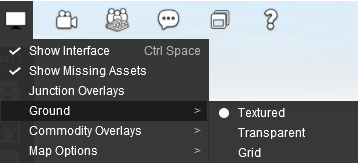
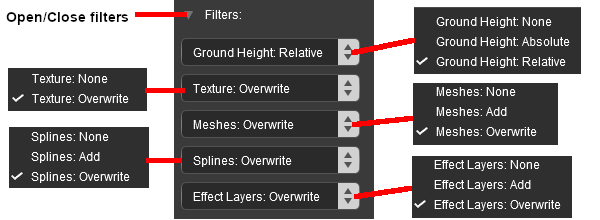
![]() Selecting an Effect Layer from the Brush Tool:
Selecting an Effect Layer from the Brush Tool:

![]() Selecting an Effect Layer from the Layers Palette:
Selecting an Effect Layer from the Layers Palette:
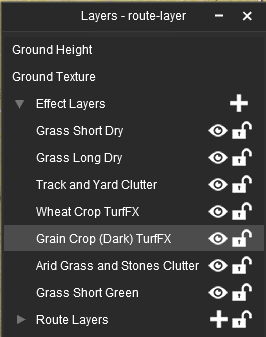
Save a Layer as a Preset below.
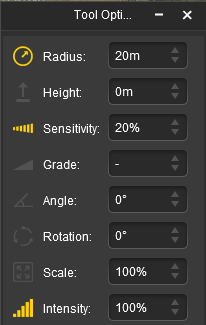
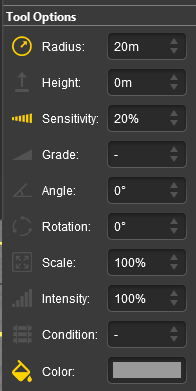
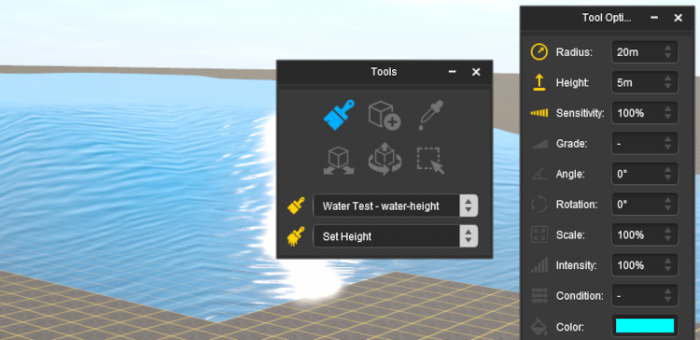


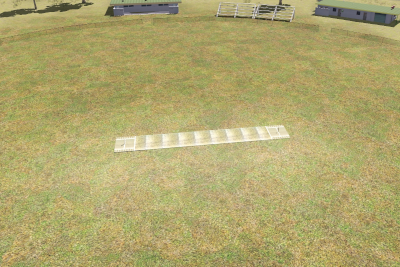
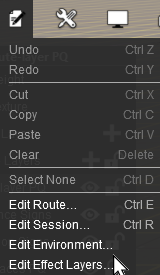

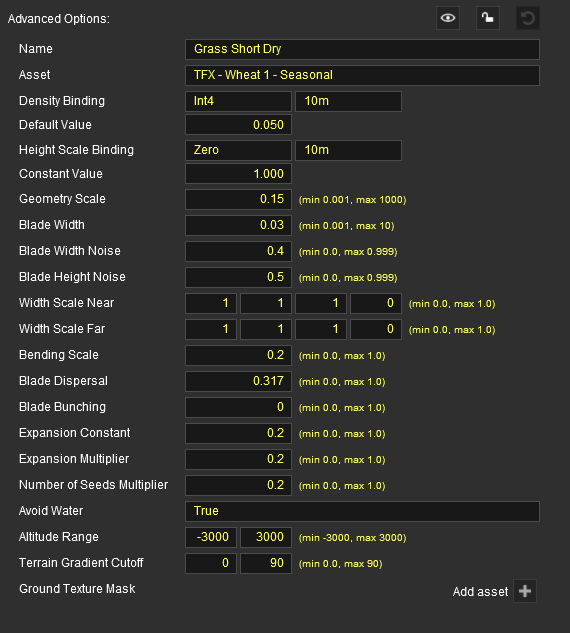

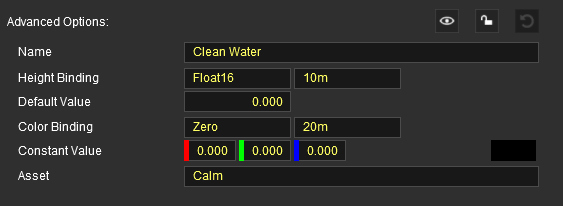



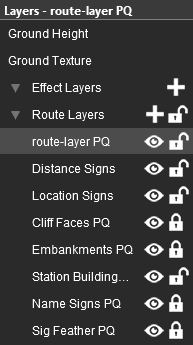

In the Assets Palette choose one of the following:-
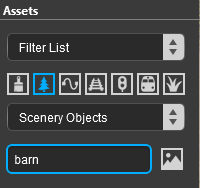
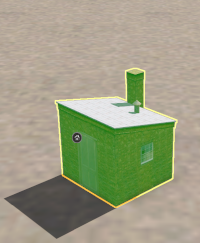
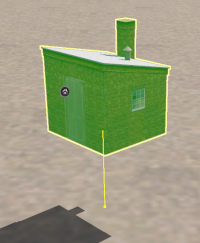
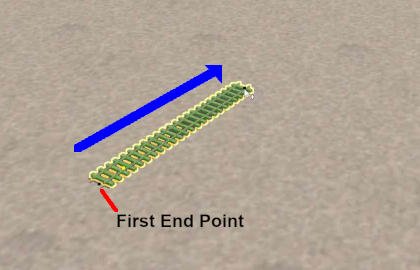
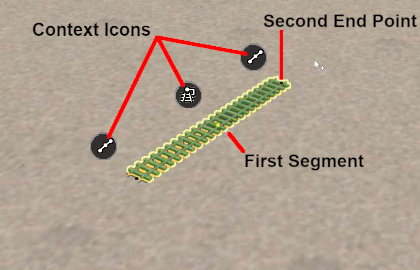
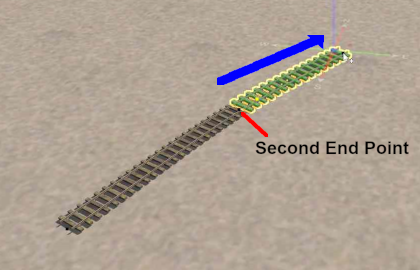
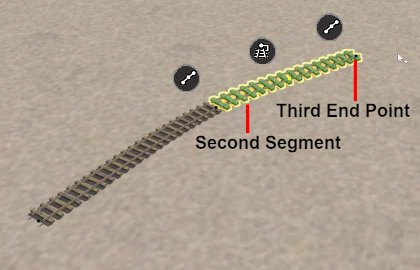

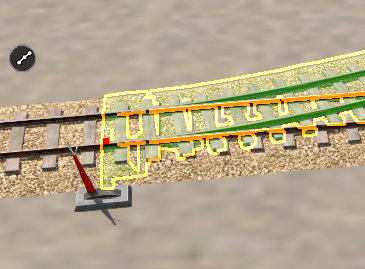

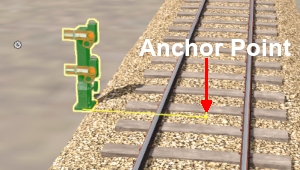
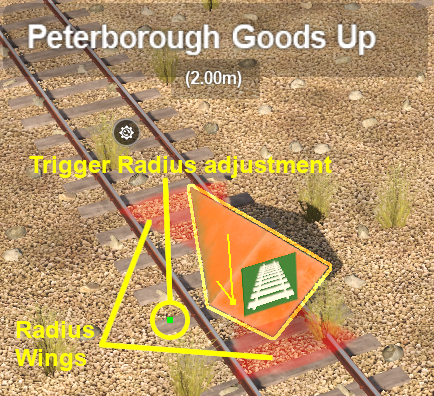
and
, or the
Shortcut , as described in
Placement: Scenery Mesh Objects above.

